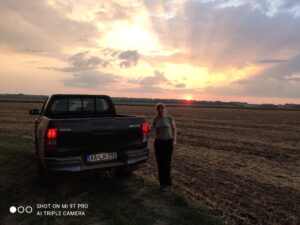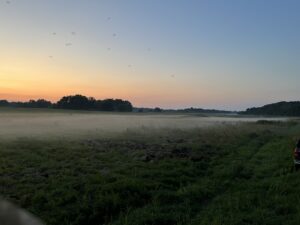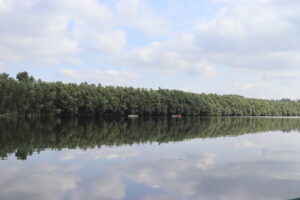After the two-week and six-week internships in Nagybajom, the next in our series of articles takes us to the beautiful landscapes of the Eastern Carpathians. The Hertán Hunting Association in Transylvania has been hosting university students for several years now, with each year's internship taking place in the fabulous mountain village of Kommando. This year, for the first time, a student from the Hungarian University of Agricultural and Life Sciences was able to get to know the spring side of local nature and wildlife management, and later, between 31 July and 13 August, seven students from the University of Sopron were hosted for a two-week summer internship on the well-established schedule. Read about their experiences and lessons learned below.
From a warm welcome to a really good team - our first days on the ground
Fülöp Anna Flóra
After a long journey, we arrived at 9pm at the training site, where we were welcomed with love and a warm, delicious dinner. From the very first moment we felt the kindness and directness with which Attila and his wife welcomed us. After dinner, due to the late hour, only a quick introduction was made and then the programme for the following day was presented.
Gabriella Mészáros
On our first morning, we woke up to the sound of pounding rain. We looked out the window and saw a picturesque landscape shrouded in cloud and mist. And although the scenery was breathtaking, it slowed down our work a little, so Attila gave us a briefing on the current and recent hunting practices and legislation in the Commando. To my surprise, there is a huge difference between Romanian and Hungarian game management laws. The rules here are much more binding and strict. The wild boar population (Sus scrofa), which used to flourish in the past, is now a figment of the imagination, its size and quality having suffered from the disease, and the main target of hunting has been the roe deer (Cervus elaphus).
Attila then went on to talk about Kommando. Kommandó is an ageing village, where there are more holiday visitors than residents. With no jobs, young people prefer to try their luck elsewhere. People live off the income generated by mushroom picking (mainly fox mushrooms) and wild fruit picking (blueberries, raspberries) almost all year round. Antlering and poaching were also mentioned. Fortunately, the latter does not cause significant damage to the local game management organisation. The orange sign and the frequent lightning strikes in the mountainous area led us to discover Kommando in the morning.
After lunch, we split into two groups and then picked up the corn, as we had to fill the spreaders. Instead of the usual shovelling onto the plateau, here we had feed in bags waiting for us to take out for the game. In the meantime, we had a very pleasant chat with Attila, who was very happy to answer all our questions. In addition to our main destination, we also made small detours to add some interesting facts to our trip. He told us that bears like to cut down trees when they want to lick up their sap, and that they even kill them during mating season.
Already we had seen a new manual spreading method, which our host referred to as, "I'm not sure if it's good, but it worked for us."
The automatic spreaders are easily accessible to the bears, which can completely loot and destroy the facilities. We approached the last spreader in silence. We watched the scenery anxiously from a closed reading nearby. After a short time, a brown bear (Ursus arctos) appeared in our field of vision. Attila told us about the animals in a whisper. The best indication of condition is the belly and ears. The belly of a bear at its full strength is large and drooping, the ears look short. In the old days, when it was still possible to hunt bears, trophies were judged by the skin and fur they were skinned and skinned. Accurate incisions at the chest were crucial as this was the best way to reproduce the monumentality of the animal. A poorly done skinning could result in a large loss of points, losing market value. In a peculiar 'commando' way, the white stripe, which is used to identify young specimens, may be retained here as adults. Our specimen was a three- or weak four-year-old female bear. Locally known as a "bear cub", she was quite timid in her possession of the litter. She stopped several times to listen, sometimes leaving the area, but did not go far except to the nearest cover, from which she quickly returned. We really enjoyed watching this unusual animal.
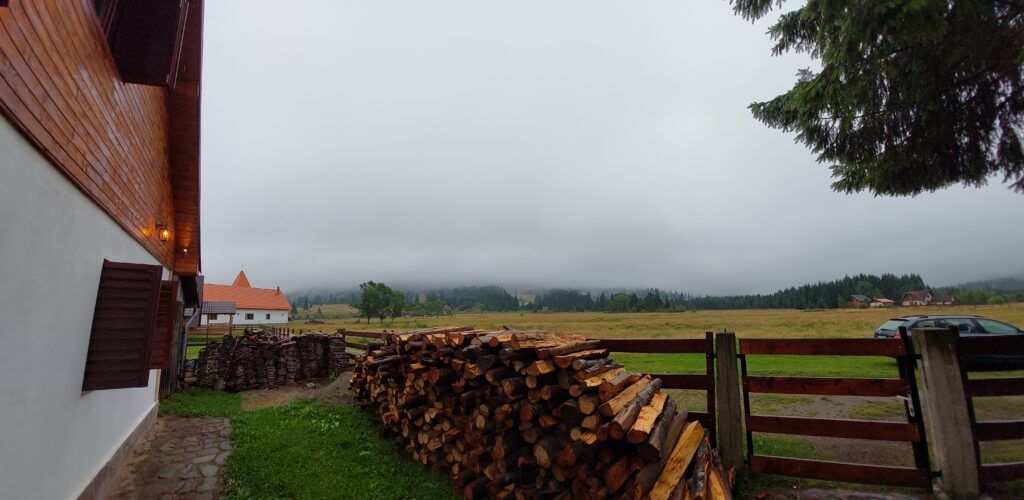
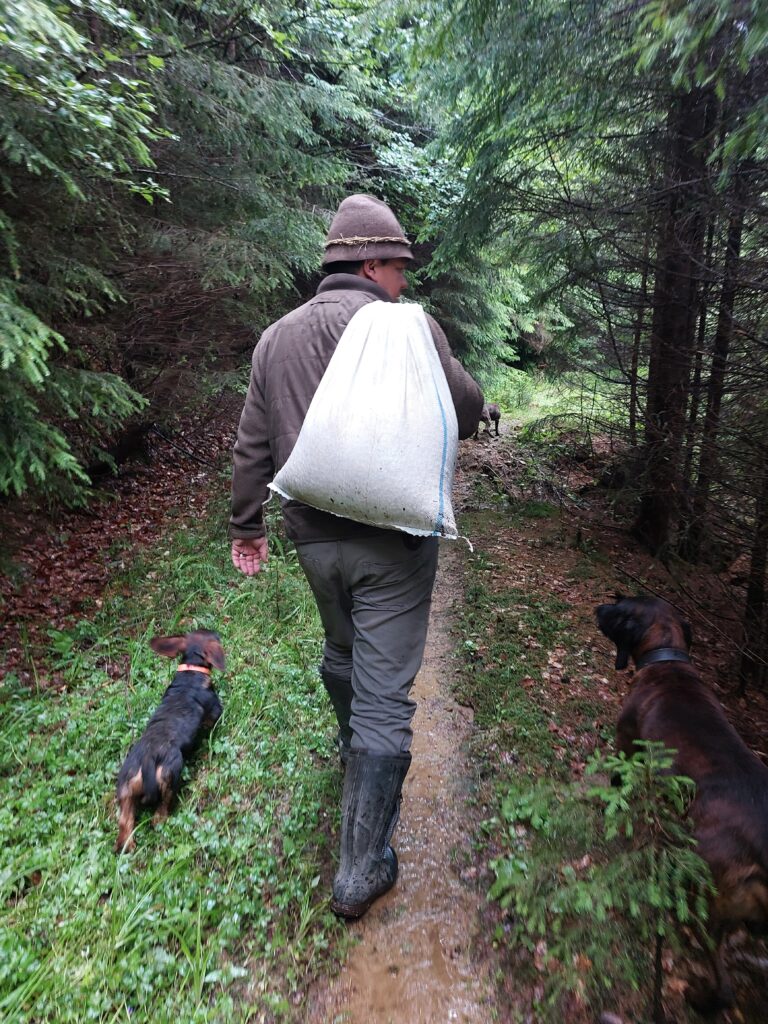
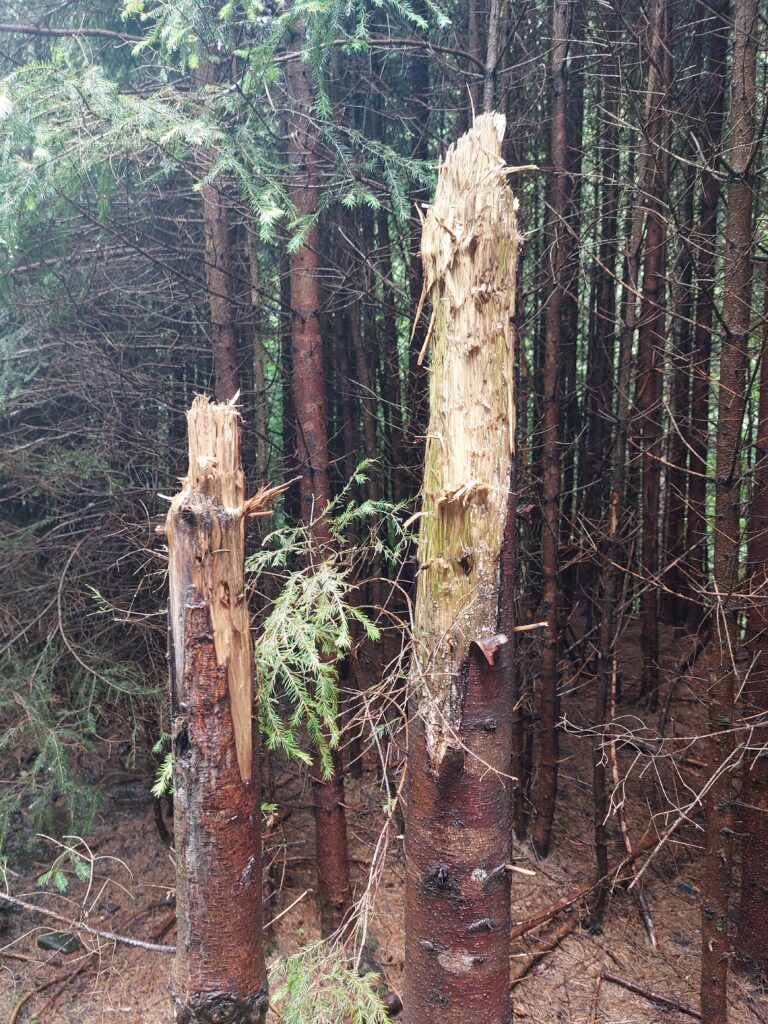

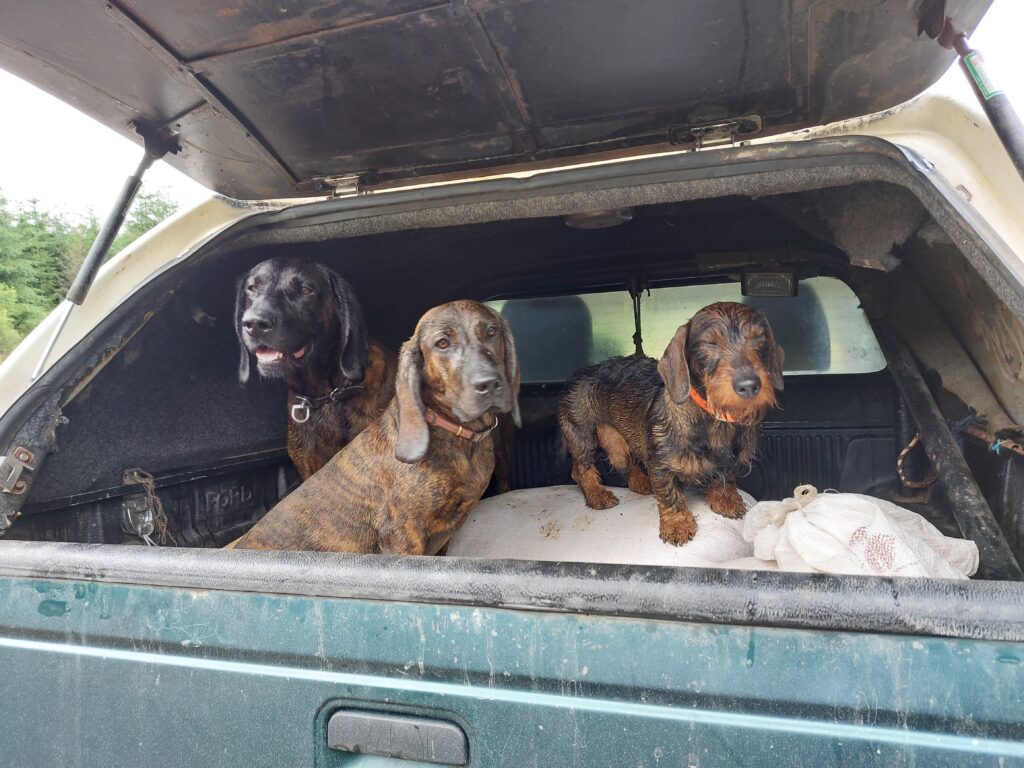

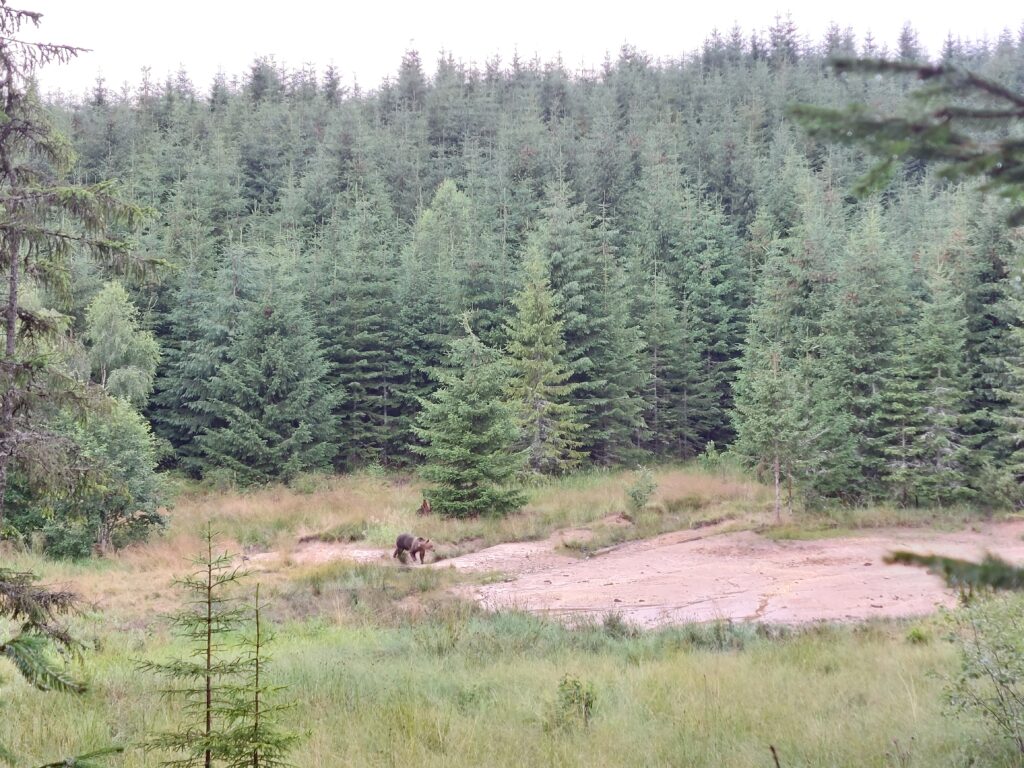
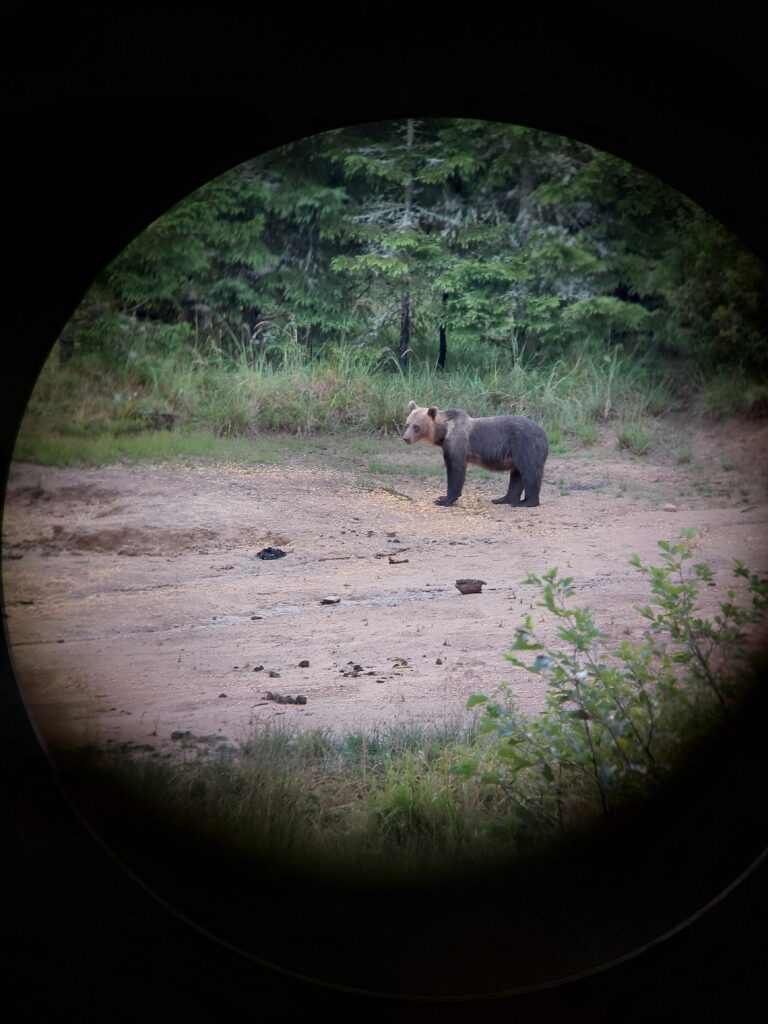
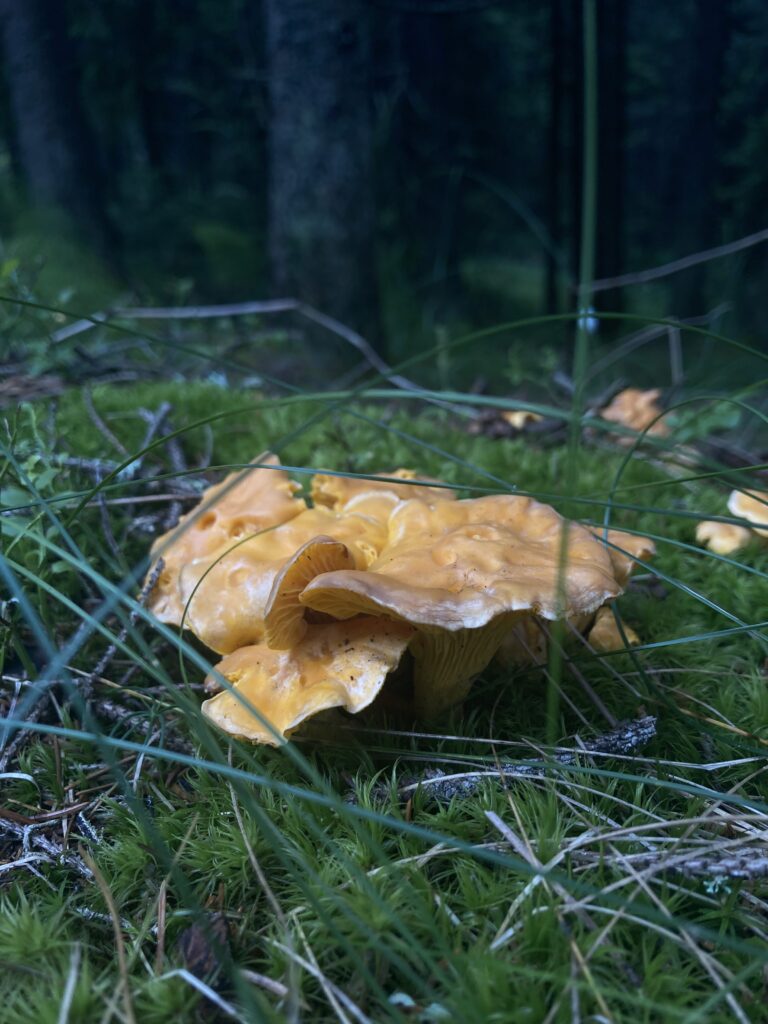
The next day we met the third member of the team, Ritsi. At the hunting lodge, we started to cut the boards for the ambush and put them on the platforms. When this was done, we were divided into three groups, and our team, led by Boti, set off on a journey through some of the most beautiful scenery.
You can't get tired of the beautiful mountains of Transylvania, nor of the hundred-year-old beech trees (Fagus sylvetica). We didn't even recognise the beech trees from the car at first, they have a completely different appearance to the familiar trees of the Sopron Hills. Their bark is more knobby, thicker and more branched. They no longer have the familiar straight, Chinese whiskered trunks to which our eyes are accustomed.
We were the first to arrive at the site, near which a flock of sheep was grazing. From spring to the end of summer, they are on the pastures with the shepherd and the dogs, so the two groups do not disturb each other when they are bawling. The others were busy adding to other pastures, so we selected from the many spruce (Picea abies) trees that could become part of the pasture. Boti selected trees that were still quite stable, but their crowns were already dead and they would not have stayed in for long anyway. We looked for suitable material for legs, supports and ladder parts. The general dimensions to which the logs were cut were 5; 3 and 1.70 m. Finally, we looked for flat stones that could go under the footings as they were not buried. The excavated timber was hauled back to the planned bury site. Two rounds of hauling took place, giving us time to test a local feature in between. I mentioned earlier that one source of income for the locals is blueberry picking (Vaccinium myrtillus). We used a home-made tool called a comb to do this. Starting from the bottom, the combs hook into the plant and, as the name suggests, are used to comb the fruit. The blueberries can't fit between the teeth so they are placed in a storage compartment fixed to the bottom. You can pick enough to live on pretty quickly in a good crop. I was totally immersed in the picking process, as it's one of my favourite foods.
Fülöp Anna Flóra
The other team was led by Richard. Our task was mainly to correct a hole, which we had to paint with preservative oil and place a bench in it. As soon as we were done, the second station headed for the team led by Attila, and once we had finished our tasks here too, we rushed to help at the last station, where we had to build a high ladder.
Gabriella Mészáros
Once all the teams had arrived, we started to build the les. We had to tidy up the path to the ambush, clearing it with all the tools at our disposal (rake, hand, leaf blower and grass cutter). Others helped lay the foundations of the ambush. I found that once the foundations were successfully laid, the work went more smoothly. To paint the planks for the outside walls we used tired machine grease. We were able to finish about 70% of the work, but overall I think it went well.
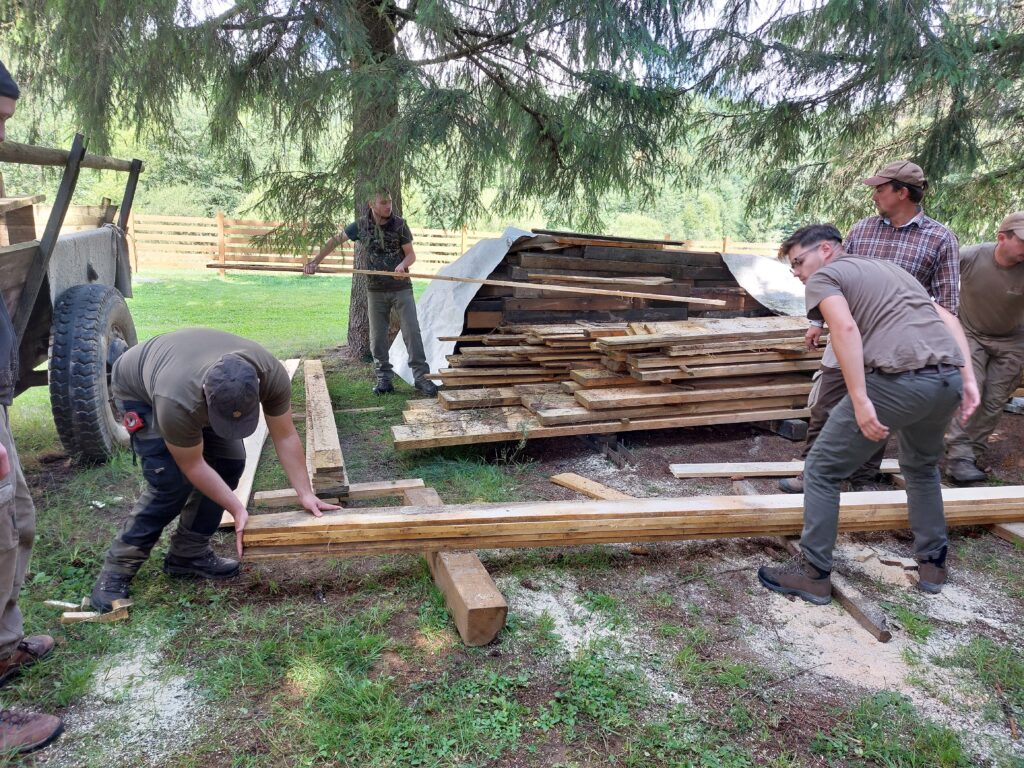

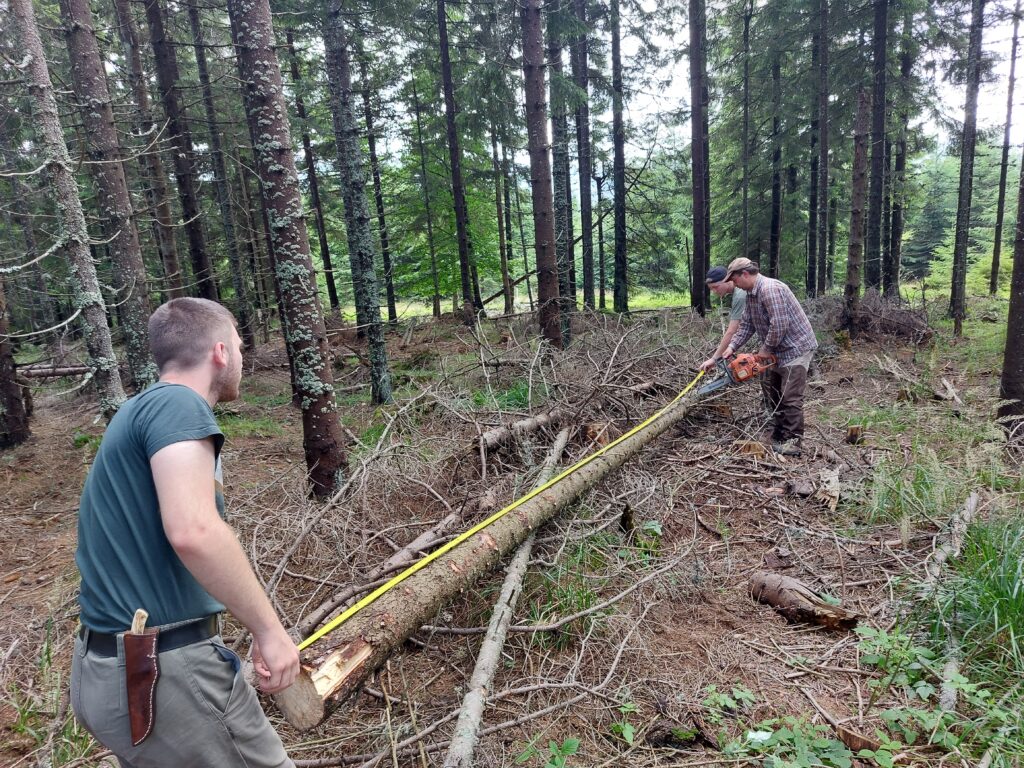


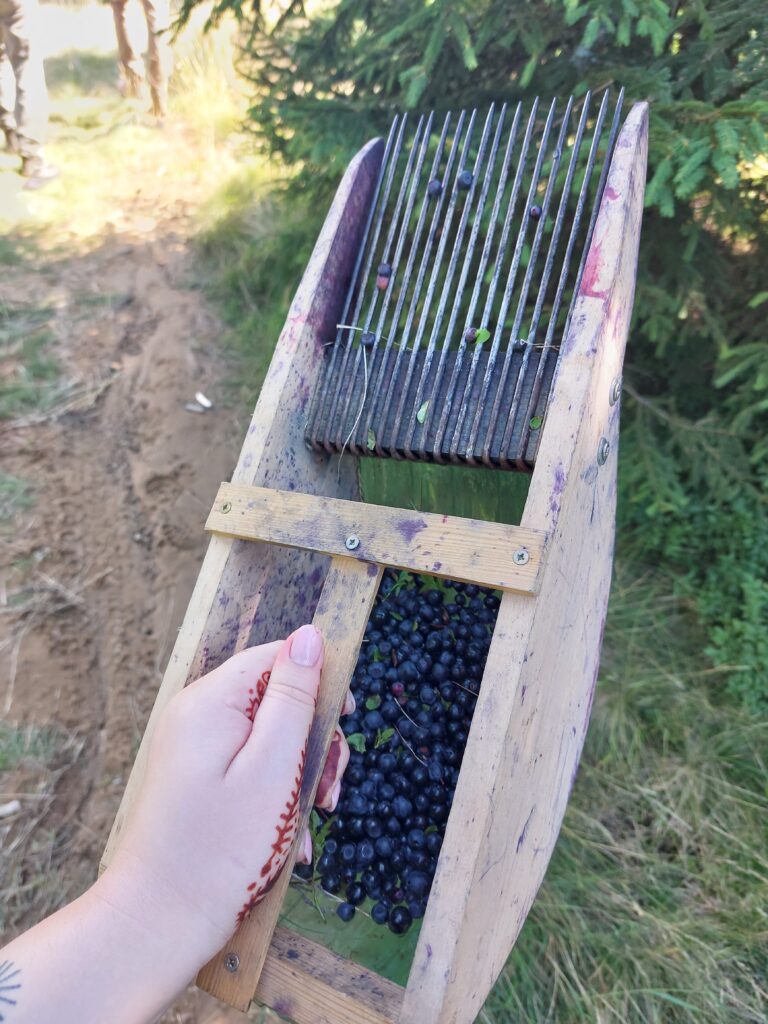
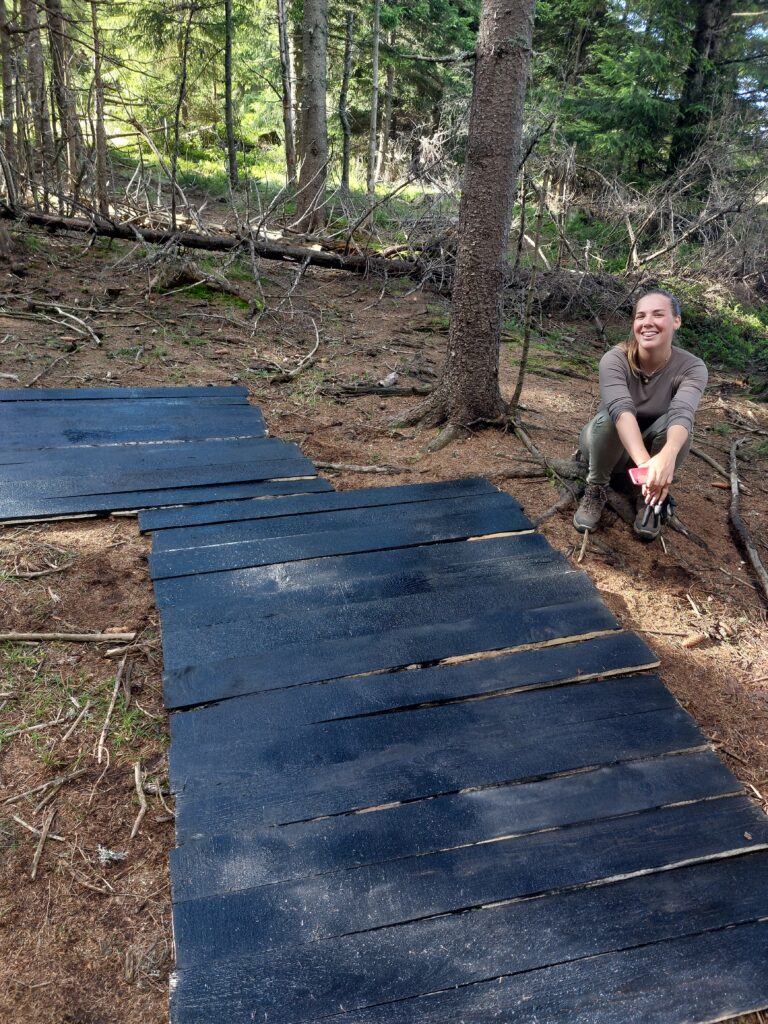
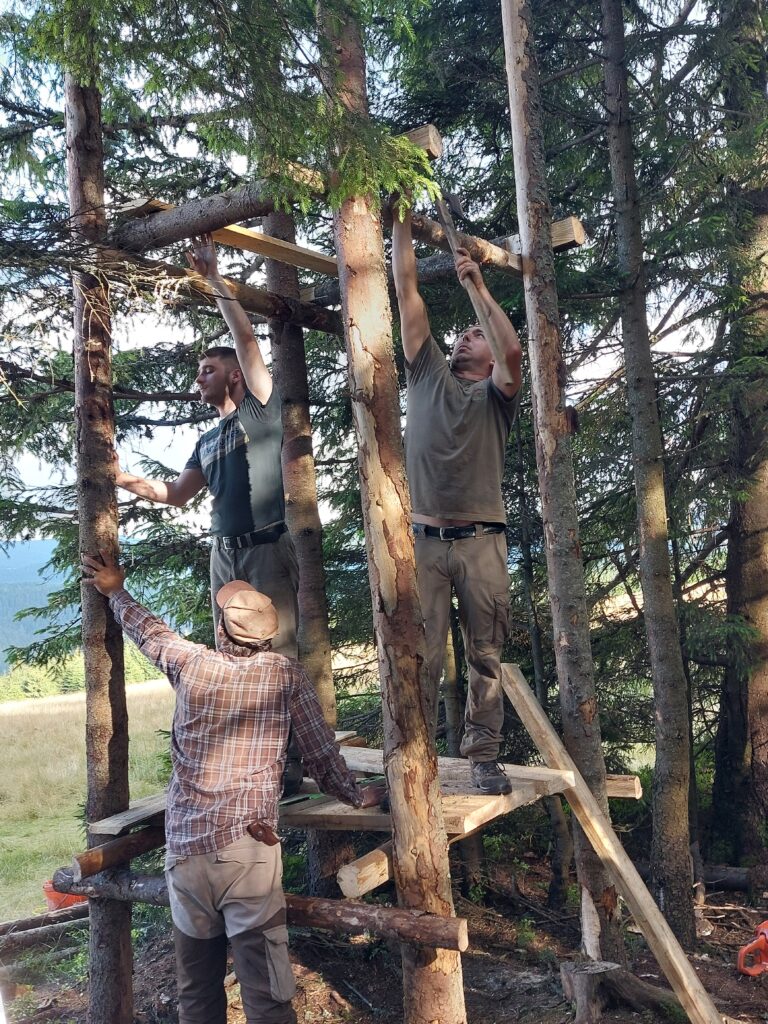
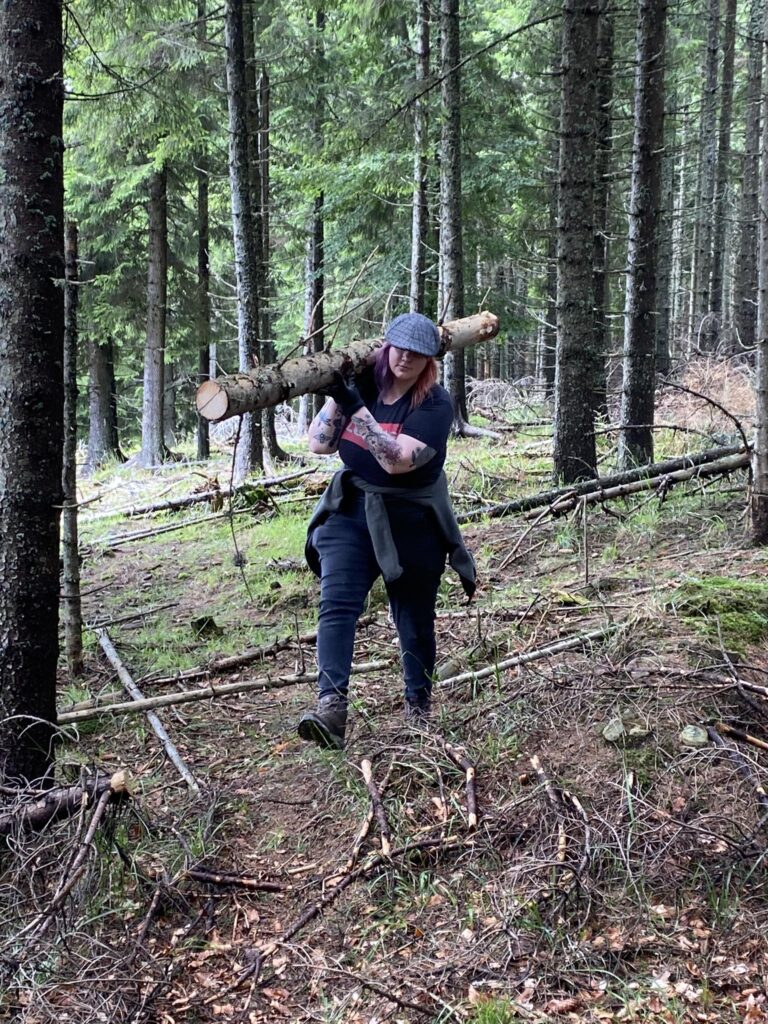
We got up early on Wednesday. Boti arrived at 5:30 on the dot to pick us up and we went to load the spreaders and salters. We finally arrived at a spreader where, unlike before, the presence of game was quite noticeable. The spreader, coloured with swamp, was less frequented by bears, with the presence of wild boar and antelope being more noticeable. During the drive, we saw a young roe buck (Capreolus capreolus) and a bunny (Martes martes), the latter just quickly darting across in front of us.
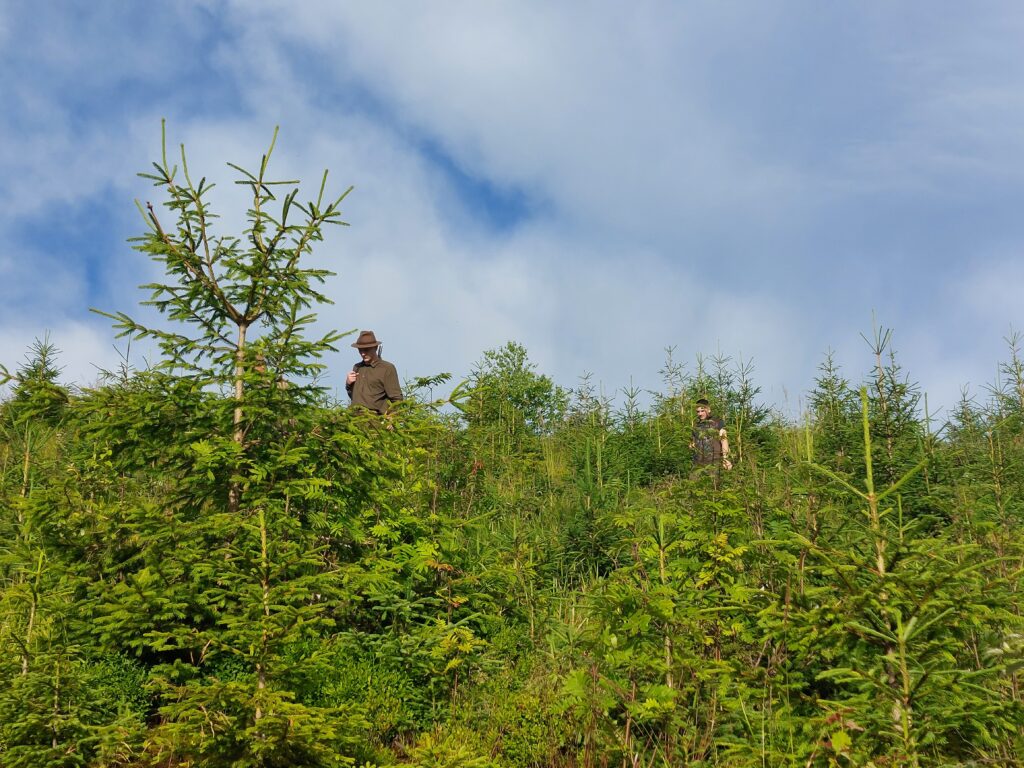
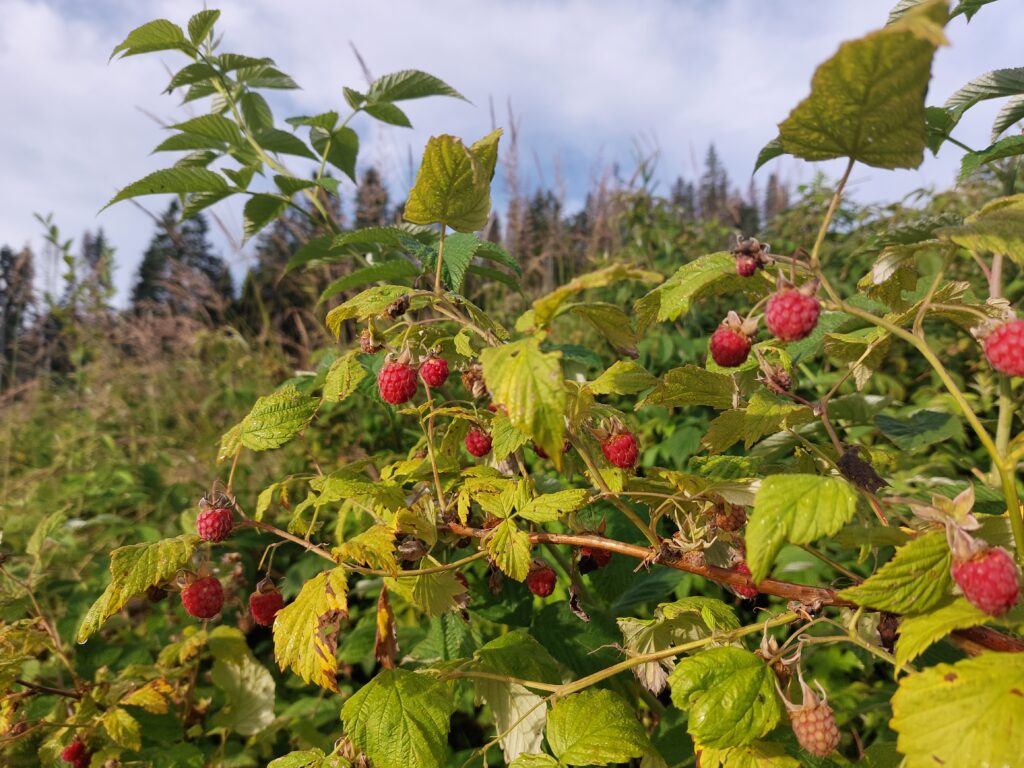
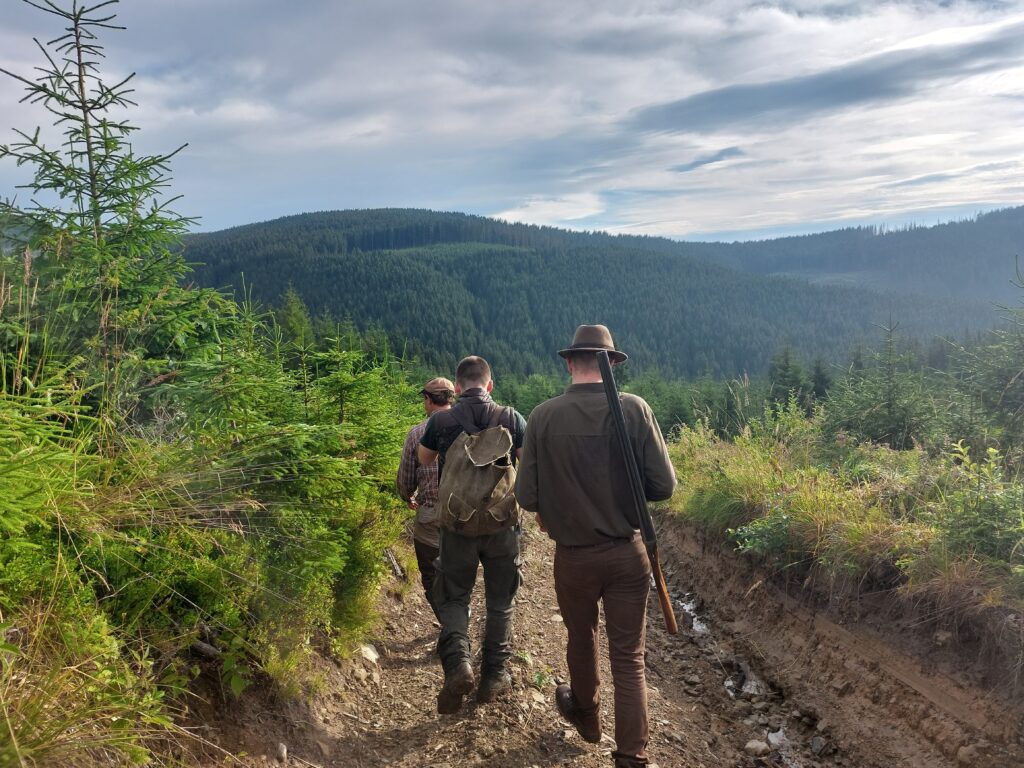
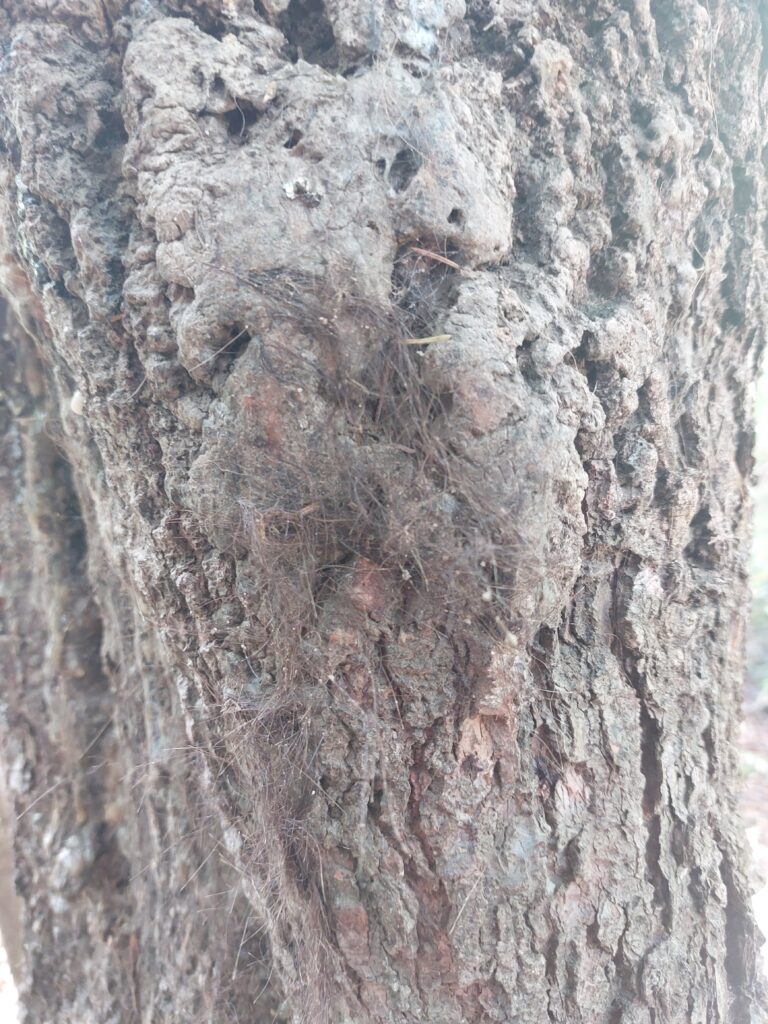
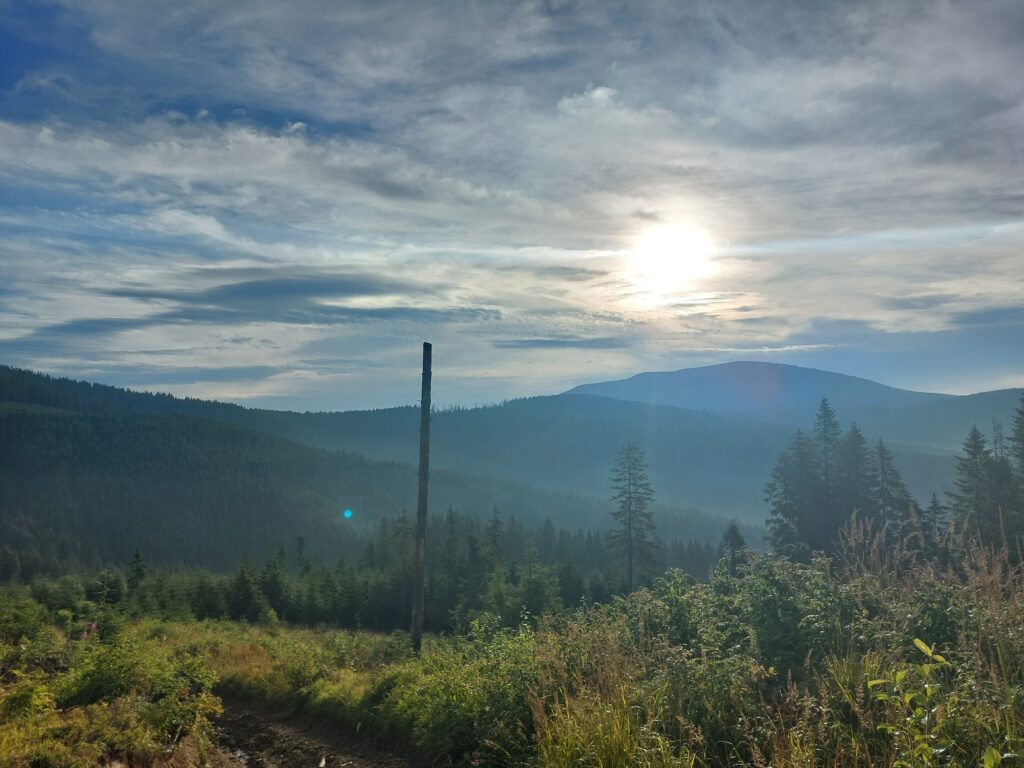
On Thursday morning we went to the hunting lodge yard at 9am. There the packing was already well underway with the supplies for an afternoon barbecue. Anna and Gabor were taken out to our camp by Attila to finish it together. The others, led by Boti, went to a marsh prairie. Our task was to dismantle the fence there. First we used a crowbar and a hammer to pry off the nails that held the posts and the fence together. After some initial clumsiness, we soon got the hang of the technique. Once the nails were prised down, the fence parts had to be rolled up. This proved to be the more difficult task.
In the summer heat, the sun was burning our skin, but our spirits were high, everyone was working flat out, and by the fourth day we had a really good team.
We only interrupted the work because of the barbeque made by Boti's wife Zita. A very cosy little camping site was set up in the cover of tall grass, next to a stream. As always the food was impeccable. We arrived back at 5pm and arranged with Boti to go out with our usual smaller group for a game of ambush. Although we had a difficult start to our bear hunt, it was a very good time, we laughed in a continuous voice and tried to keep quiet, so we were lucky not to miss the 4 boars and a bear that visited the spreader.
The bear was apparently unconcerned about the presence of the boars, even when a dominance clash developed between two males. However, there were some pigs who, as soon as they saw the bear, left.
He did not go far, of course, and contemplated his options from the shade of the forest. We stayed a little longer than we should have, so we arrived back in the dark. We thanked Boti for this wonderful adventure and went into the building to get ready for the next day
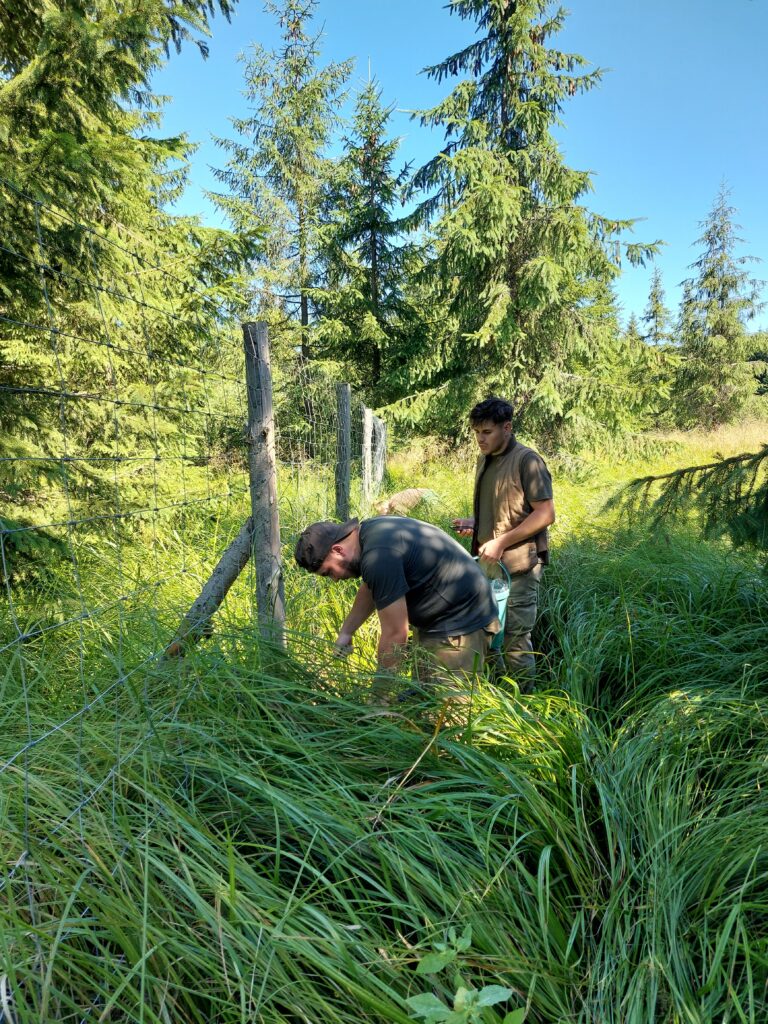
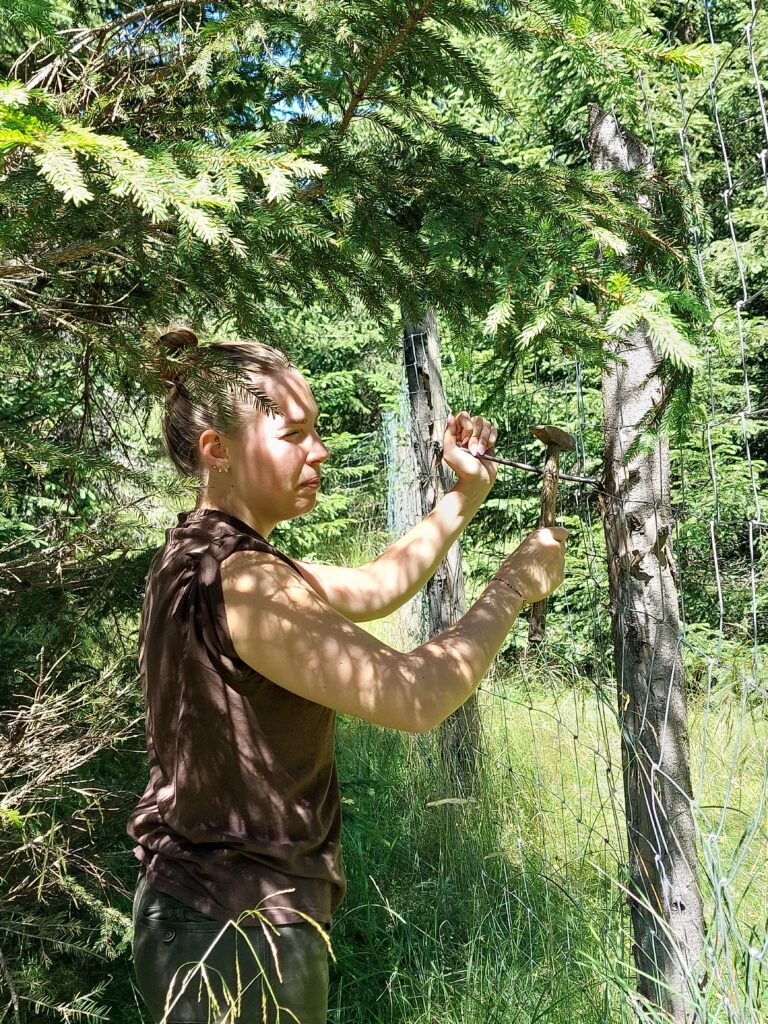
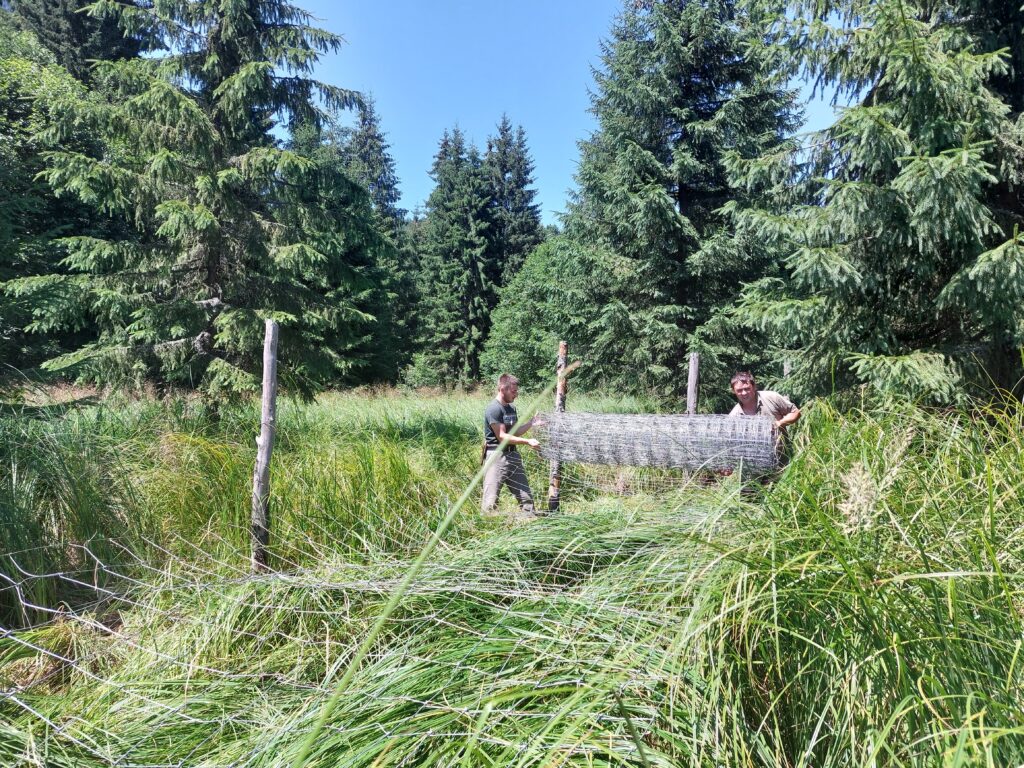


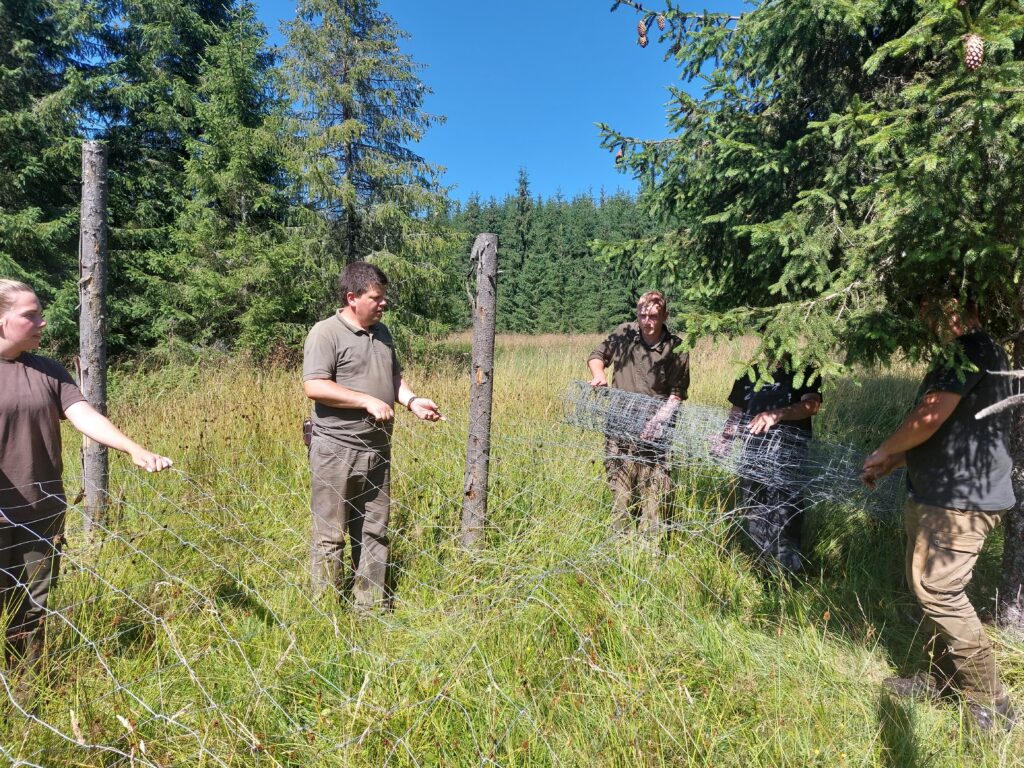
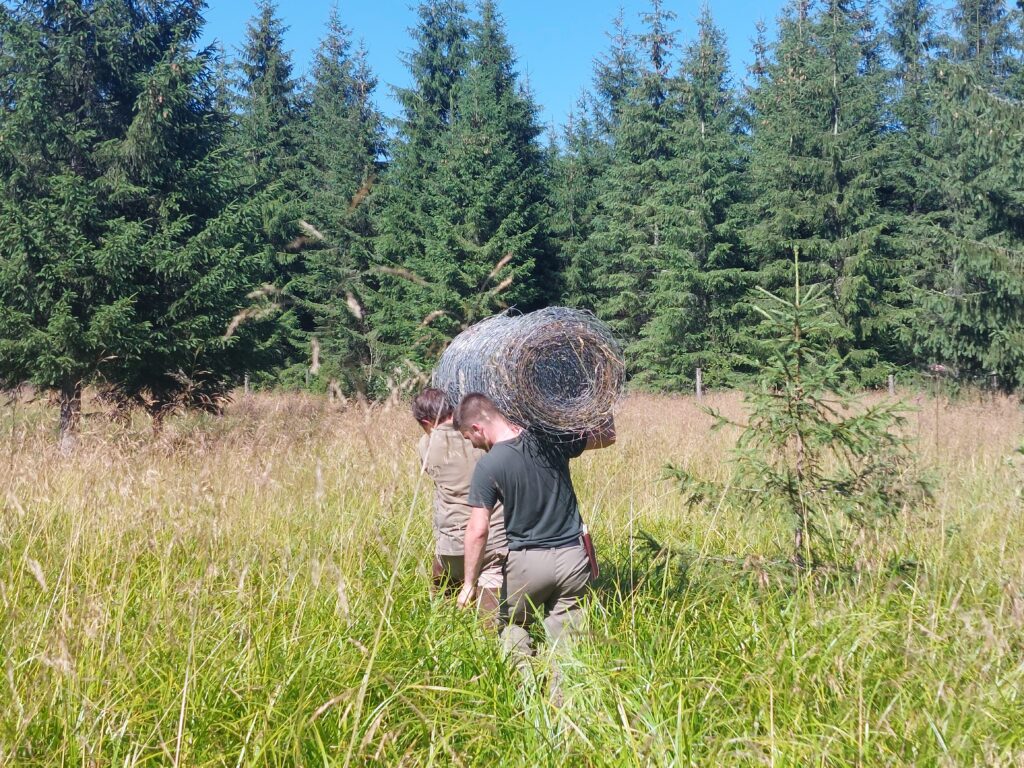

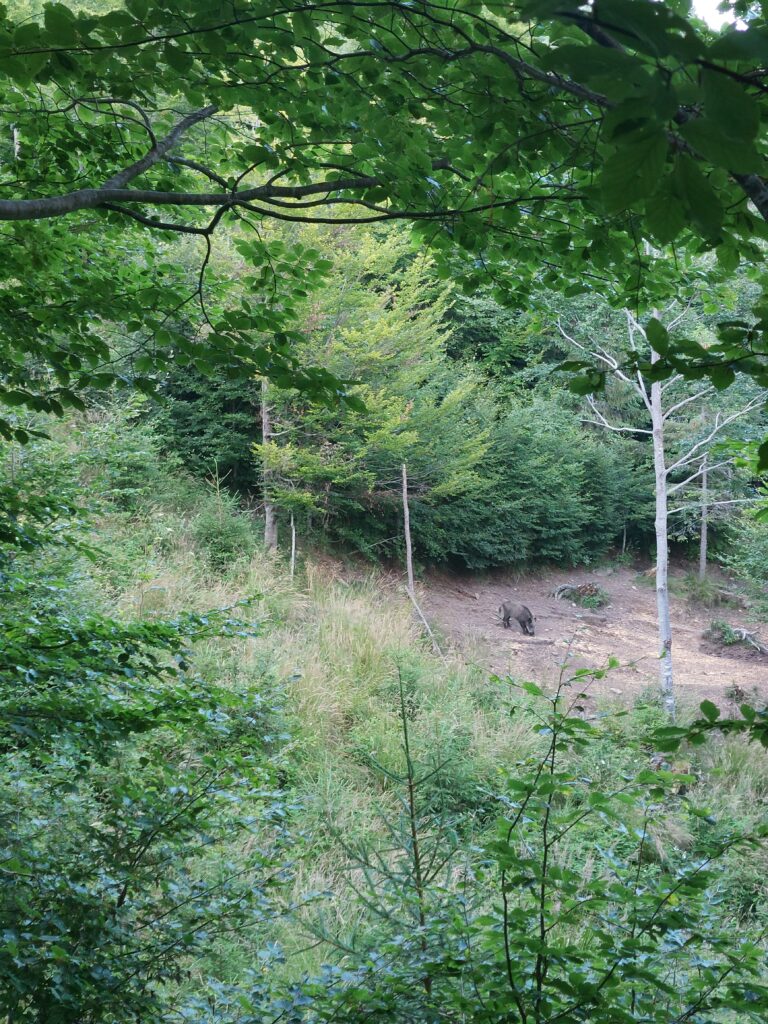
Feeding construction, medveles and a night on the lesen - more adventures in practice
Fülöp Anna Flóra
On Friday we had another more complex task; we had to build a feeding trough. The day started in a similar way to the previous one, at 9am we gathered at the hunting lodge, packed up the necessary supplies and materials and set off to the site. Once again different teams formed, this time I was in a team with Attila, Bodza and Gábor. We were the first to arrive at the site, then we surveyed the area and started the clean-up to make the work easier. We set up this wildlife management equipment quickly and accurately, everyone was able to help with everything.
Richard Bakondi
The big-game hide is located next to a favourite deer turnout, so it will provide a good source of food for the animals in the cold and harsh winter conditions. It's important with a big game feeder like this that the roof extends beyond the basket section to allow rainwater to run off beside the basket. In addition, we insulated the roof with tar paper to prevent rainfall from falling in and cracking the straw.
Fülöp Anna Flóra
As soon as we got back, after lunch, there was an opportunity to go out to Medveles at 7am. Gabi and I took this opportunity. I hunt relatively often with my father, who is a hunter. But the two feelings are incomparable. I have a little bit of excitement at home, because that's the sava-borsa of hunting. But this is different from any other hunting experience I've ever had.
The hope of seeing a bear in its natural habitat was a huge adrenaline rush. Obviously, seeing any other native wild animal would have been a thrill, but I think that's what everyone here secretly wants.
Leaving the car, we followed Boti's instructions and tried to approach the lest possible noise. I felt at the time that this expectation was not being met. It was as if we had entered another dimension, where time passes differently and sound travels differently. It seemed to take longer to reach our destination than I had subsequently assessed the distance. Even the most cautious step seemed like a loud creak, and if I stepped carelessly on a twig, it "rang out like a gunshot". From the inside, my breathing, intended to be quiet, sounded like the whistle of an intensive care unit ventilator. This big internal roar was probably inaudible from the outside, for as we approached the lest, two bears were already peacefully munching on the sprinkler. They had apparently sensed our presence, but were not particularly disturbed. I don't know exactly how I felt when I realised that I was only 30-35 metres away from these two majestic predators. But I do know that when I started to climb up the ambush, my right leg shook. If I didn't consider myself fundamentally brave, I would say I was a little scared. We had barely settled in when one of the bears (the female) got tired of our company and peacefully wandered off. Soon the male bear followed, but he left abruptly. We wondered who or what had caused the apex predator of the area to flee. To my great surprise, it was a pair of deer in a rut. So I understood: Mr. Bear knows that love is a serious matter, we don't stand in the way of nature... the bear was not frightened, but left tactfully. For the rest of the evening we just enjoyed the sounds and atmosphere of the forest. It was one of the most powerful experiences of my life, I'm glad I'm here and have these opportunities.
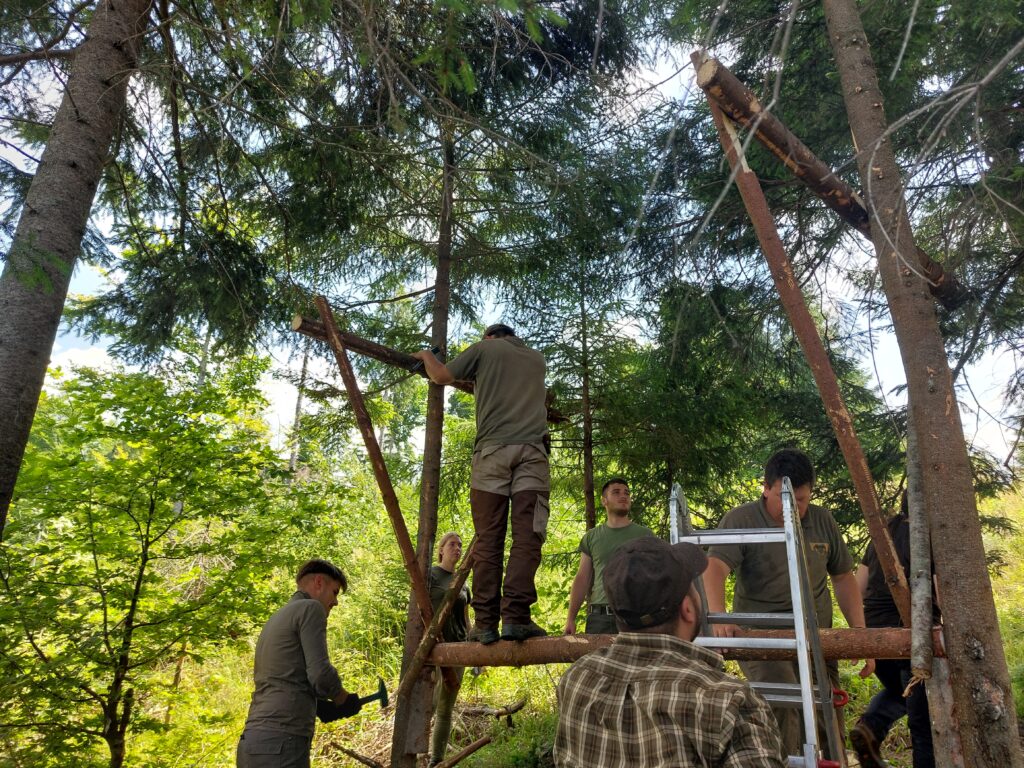


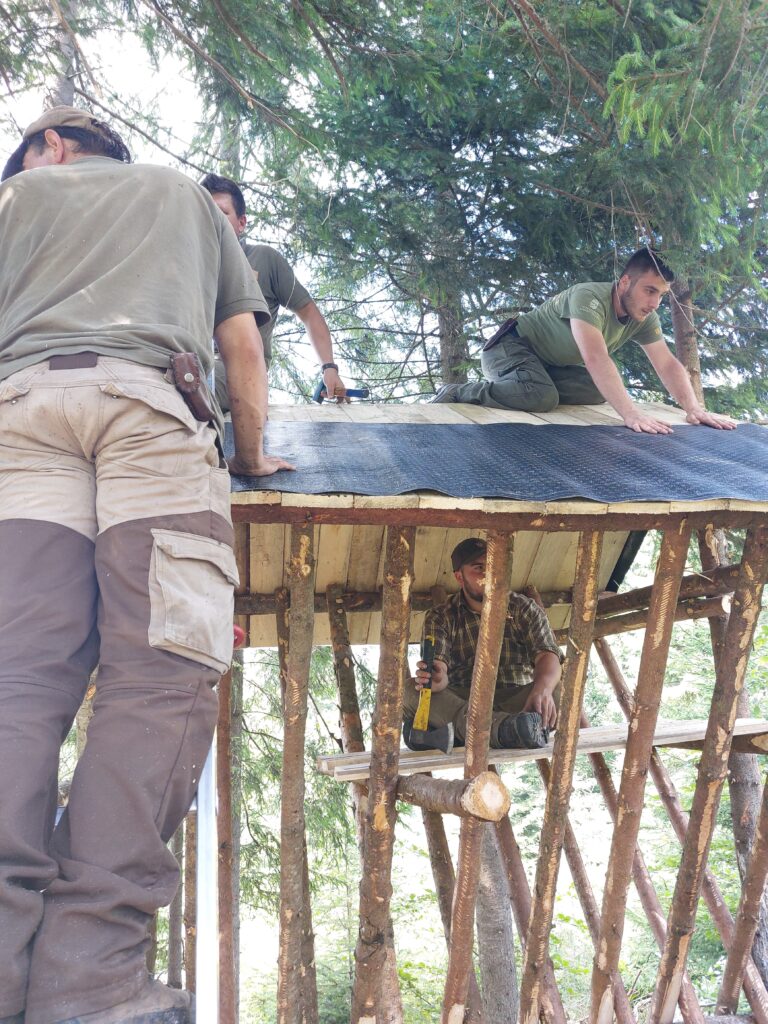
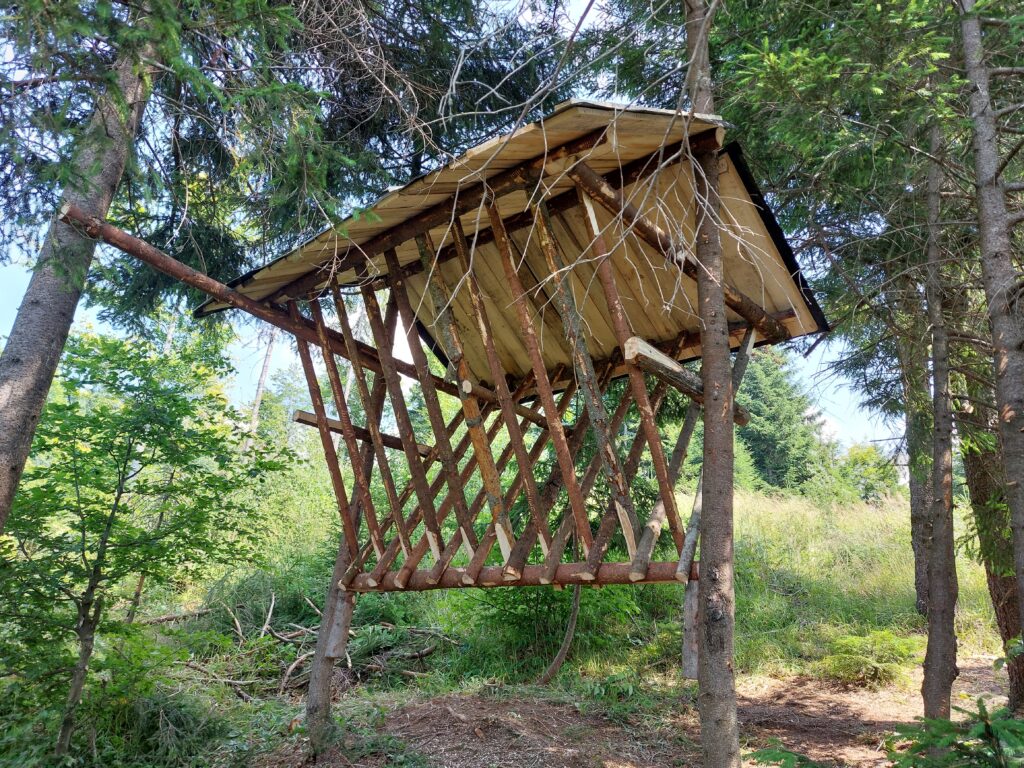

Csapó Boglárka Bodza
The night before, we spent the night with Ritsi and Attila at a lesen, where we were lucky enough to have Celeb, the brown bear, as a regular guest of the scatter, as well as a male and a sow with 6 piglets. Unfortunately, they all arrived in the dark so we were able to view them with night vision, but it was still a great experience for us. We were awakened every hour during the night to see if there was a change in the guest population, but it wasn't until 6am that the bears returned again, this time in daylight. Gathering up our gear and mental strength, we dived down from the ambush and set off to scatter and replenish salters. Later, back at the hunting lodge, we washed the car to leave everything in order for the weekend rest. Returning to our mates, we rested and attended the local village fete in the evening.

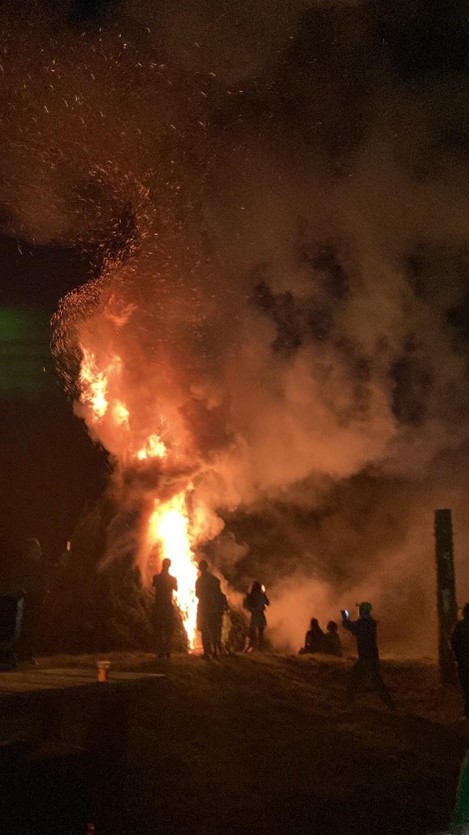
Richard Bakondi
After a rest day on Sunday, we started Monday with renewed vigour. During the morning we collected timber for the big hunter planned for Tuesday, and checked and fed two more spreaders. The tracks showed very good movement as the corn we had scattered the day before had been completely eaten by the boar and bear.
Gaberiella Mészáros
In the evening Attila and I went hiking to the best bellowing place in the area. On the way, we feasted on a variety of wild fruits, as did Attila's son Zalan and their dog Rolló. As we climbed higher and higher, a familiar line of land came into view. We could see the mountain opposite where we had set up our lest the week before. We were surprised to find that we were at the site of the view there. The view was breathtaking as it was, but with this extra information it somehow seemed even more magnificent. Moving on, we caught a glimpse of antlered deer in the distance, but only for a moment. Further up the mountain, we could see a bear in binoculars on the opposite hillside, probably eating blueberries.

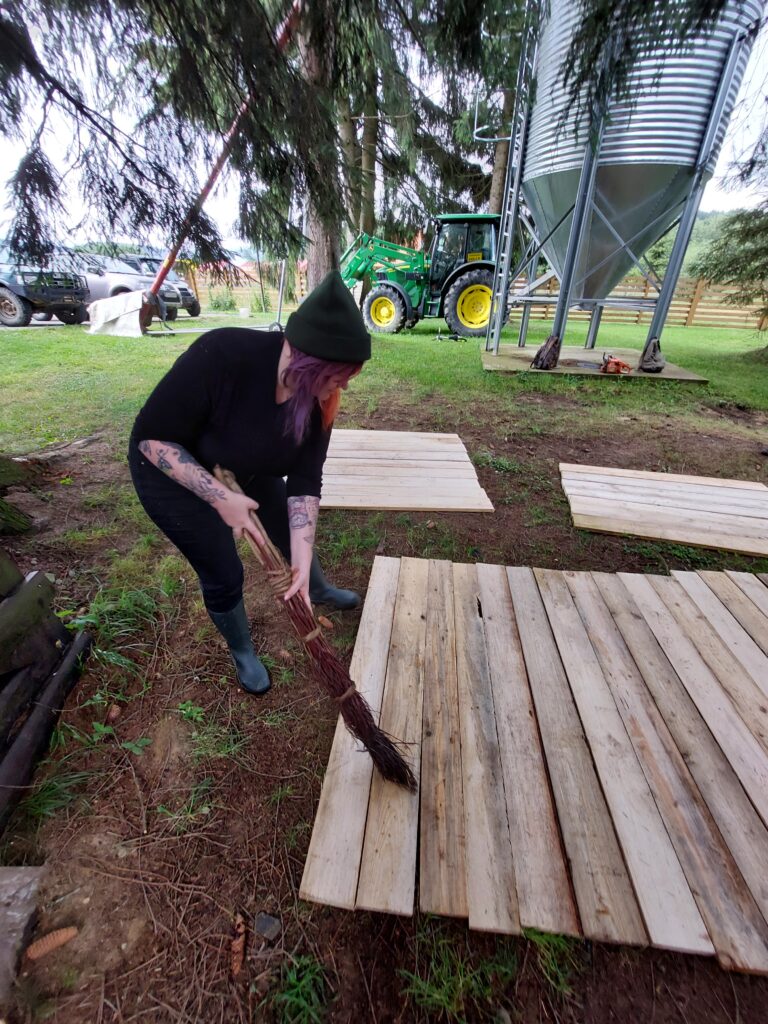

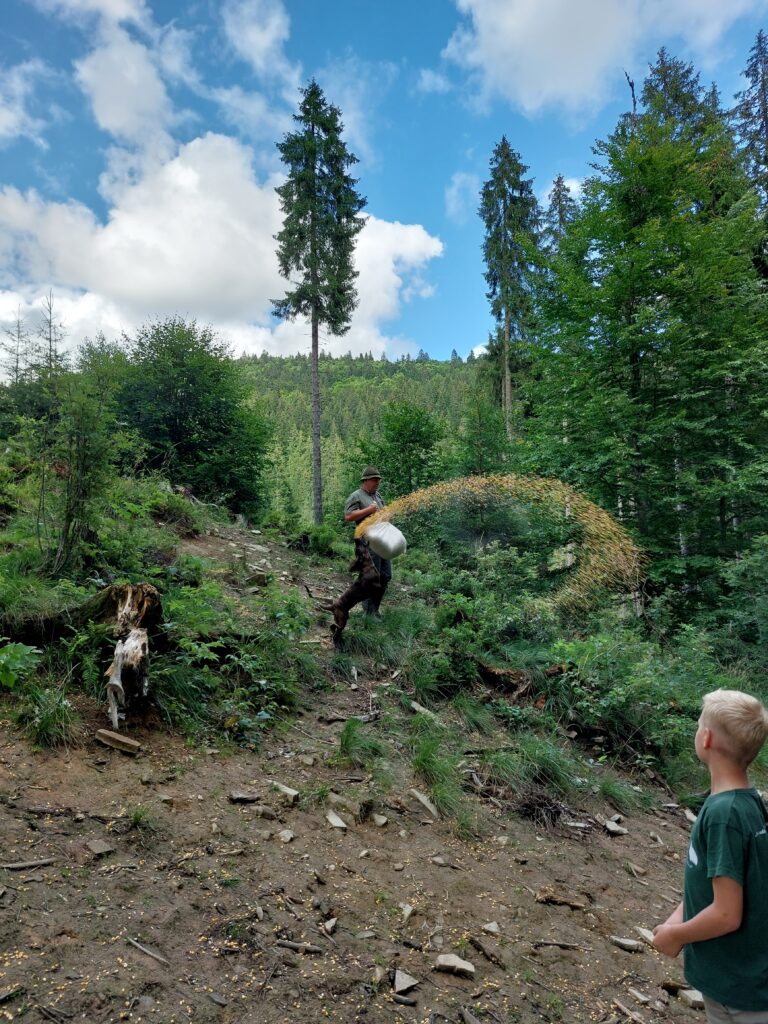

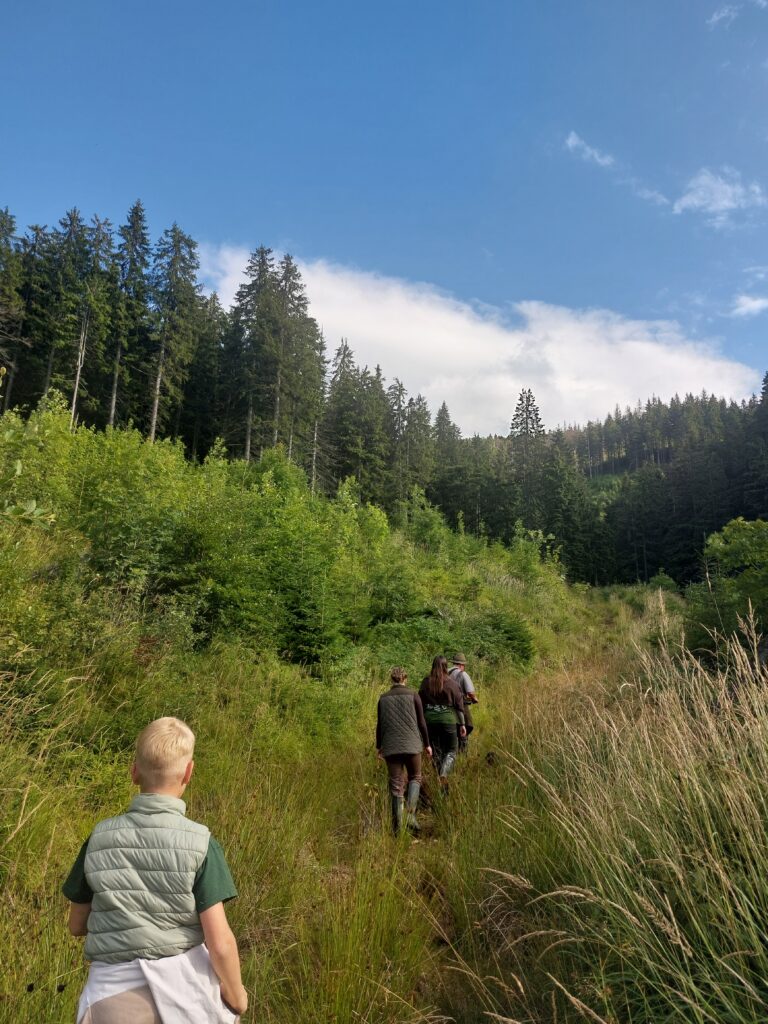



We bid farewell to the Transylvanian exercise with a sunset in Lakóca
Gábor Zimány
On Tuesday, we did our test task, which was to build a big game hunter. The weather was not encouraging and we even got a little wet, but thank God the weather cleared up. We used most of the wood that was left over from the previous feeder. In the morning we set off to the site we had scouted out the day before, marking out where to put the feeder. We set up the feeder in the valley where locals say there is good deer movement during the winter. We also built this feeder on two live spruce trees. We arrived at the site in a Polaris, as we had to transport the wood and tools far from the road. Once the structure of the feeder was assembled, one of my colleagues and I started nailing up the trees that would serve as the lattice - me on top, him on the bottom. Once that was done, we started to board up the roof. In the meantime, we also cut tar for the roof and once the boarding was done, we had that boarded up as well. After we had successfully completed our test work, we packed up and I went with one of the rangers to sprinkle another sprinkler with corn, then we headed home.
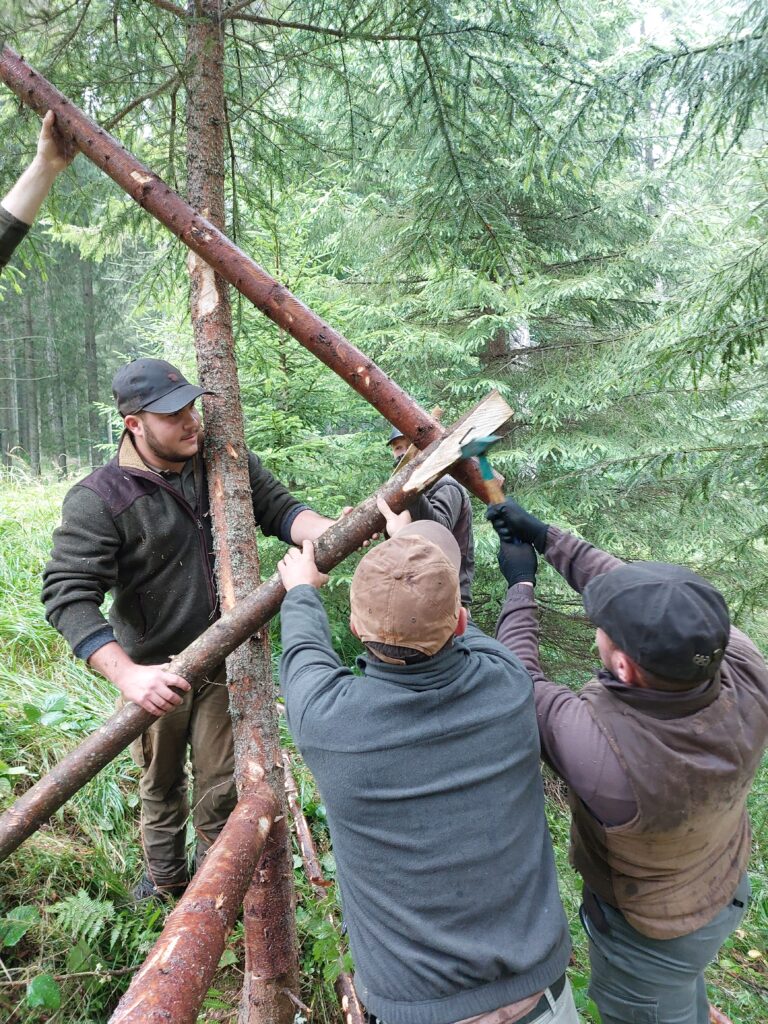
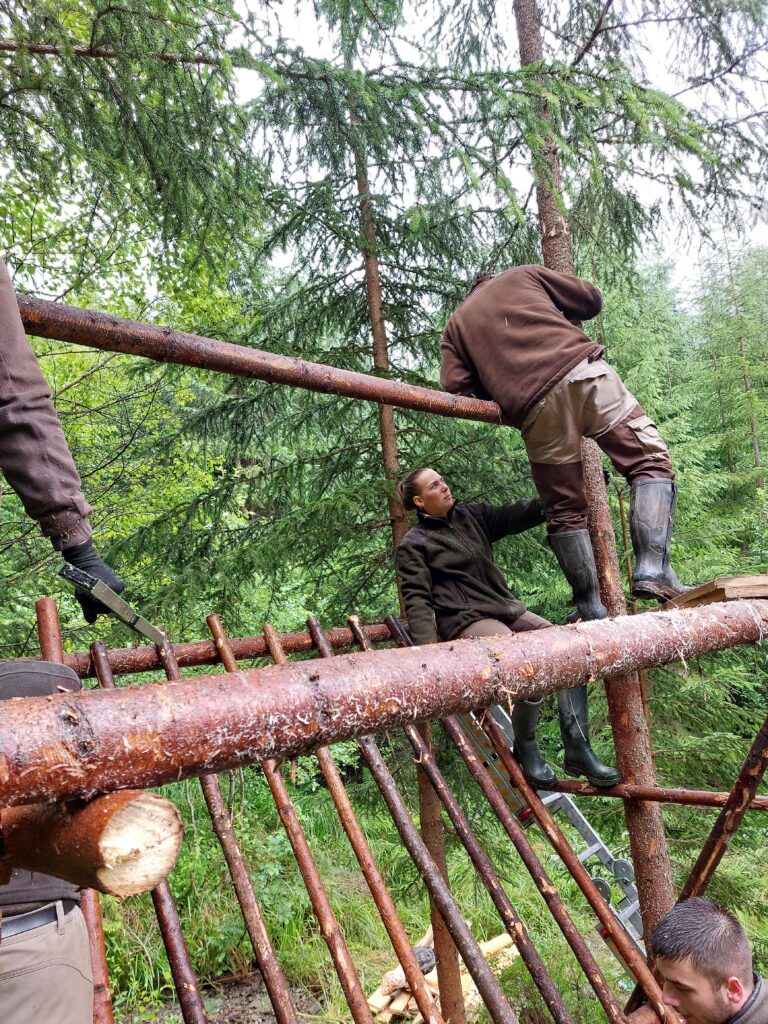
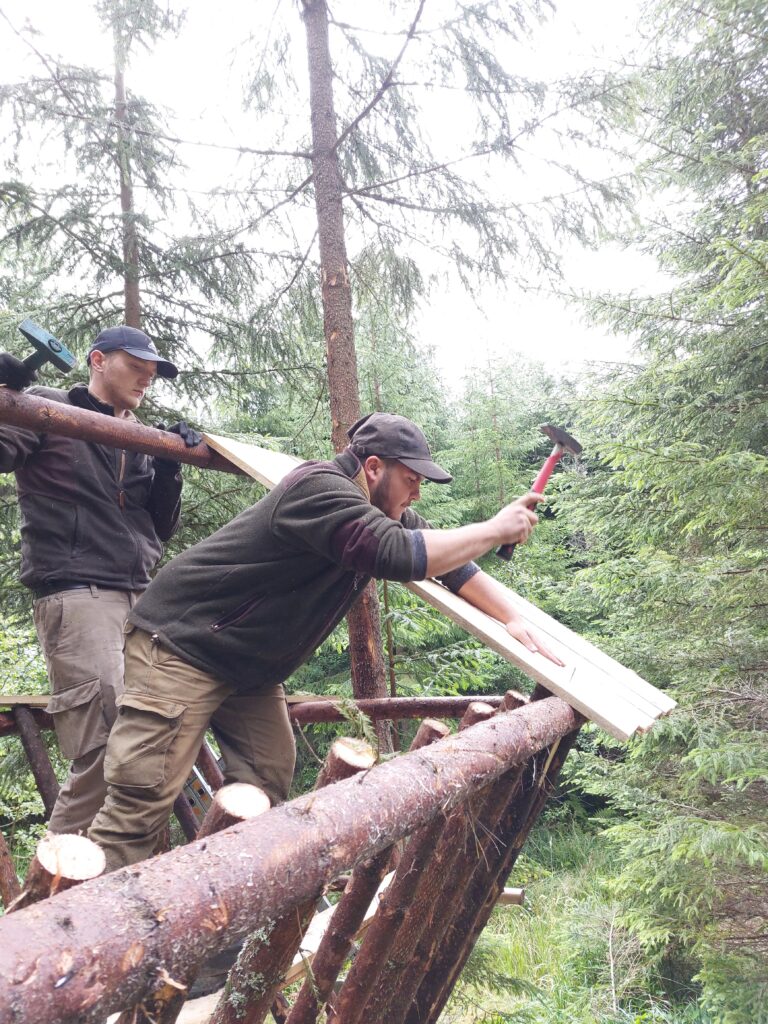

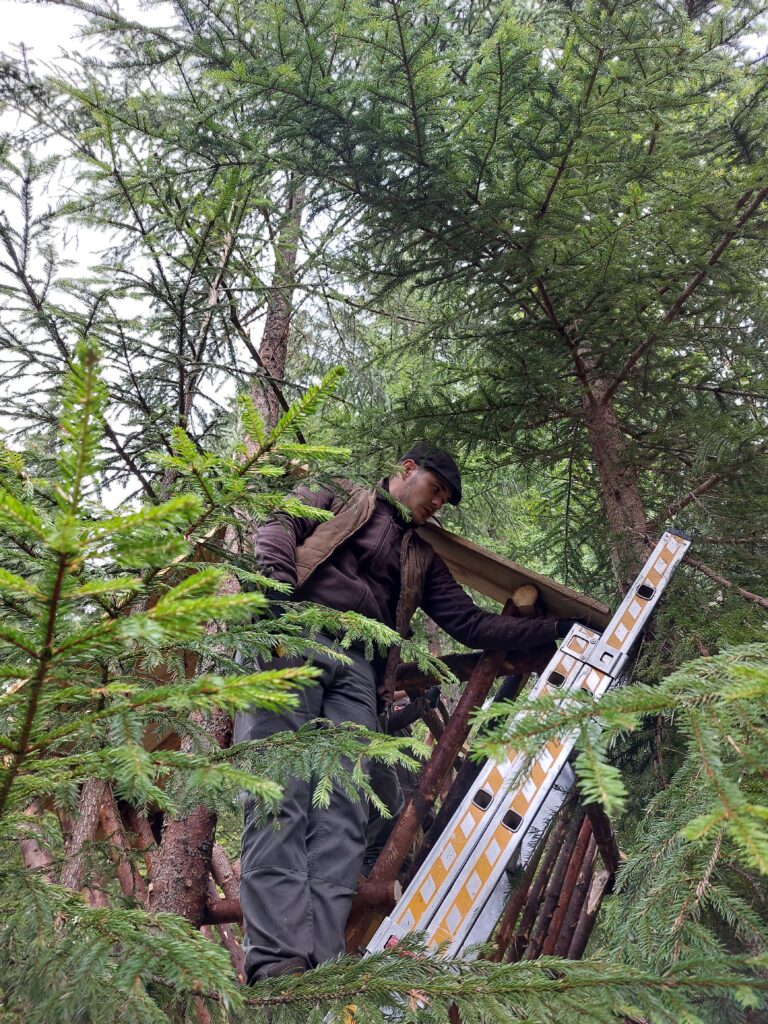

Oliver Lakat
On the Wednesday of our second week, the team arrived at the hunting lodge at 9am as usual, where we were met by packed polaris with all the materials needed to build a high pass. Thanks to the vast terrain, after an hour and a half of exciting forest travel, we reached the ridge where our hunters had envisioned the structure.
Máté Szijártó
The task was to assemble a les, but first and foremost to find the right location and transport the structural elements to the site. During the first half of the work I helped to find a place to build a fire and light a fire to prepare lunch, then I made the ladder for the camp and the stabilising side trees. We built the lodge until late, so we didn't have time for anything else that day.

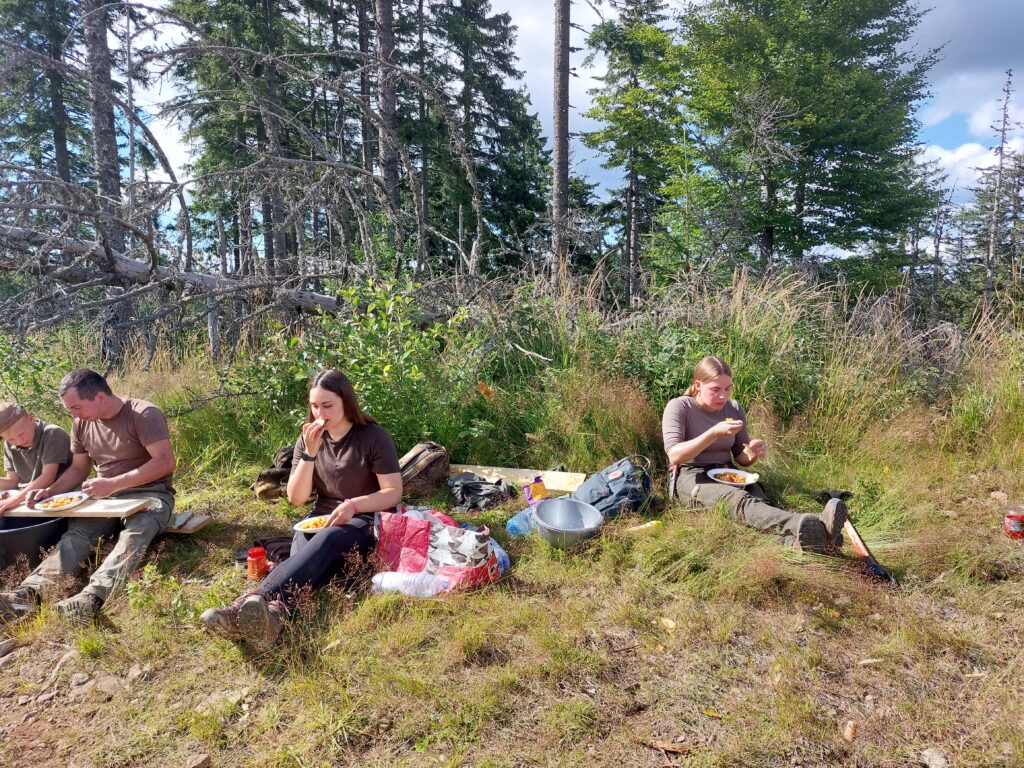
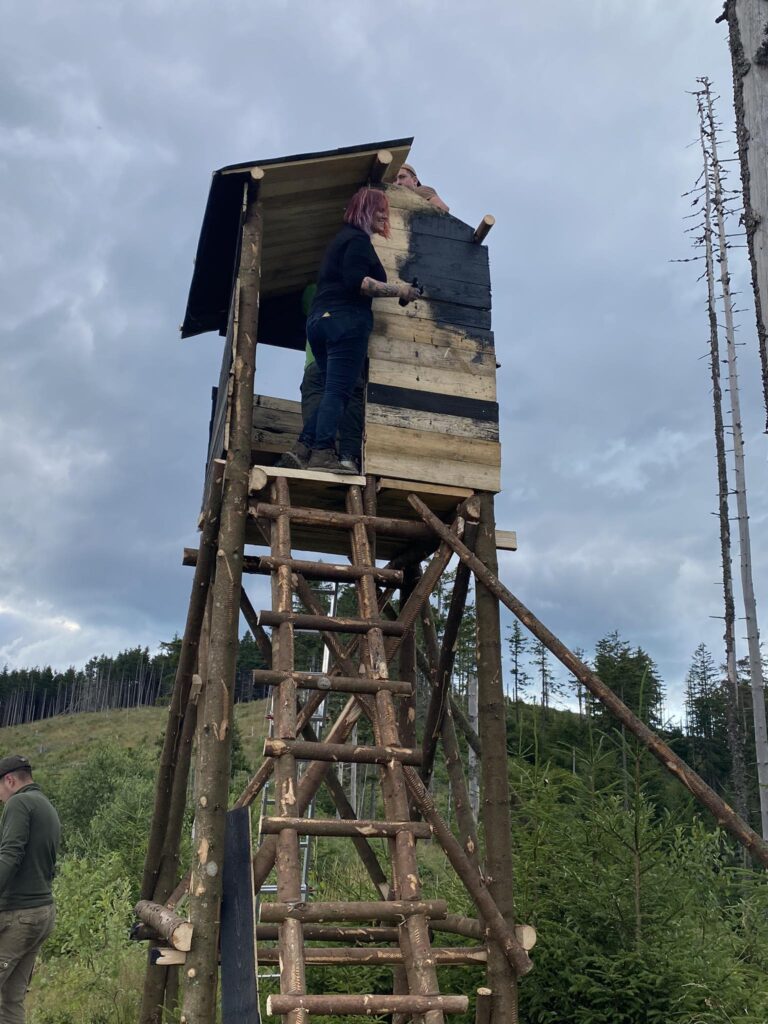
Fülöp Anna Flóra
The next day we started later, at 10am. We rushed to clear a scout path, first with Attila and Bodza, the three of us went to clear a path, here we raked, picked up the larger branches and went along the path with a leaf blower. This area is the best browsing spot for the Hertan Hunting Company, where a lot of deer turn up, up to 6-8 bulls browsing at the same time. Attila said that out of 10 deer, 6 fall here.
Richard Bakondi
As the rut is about to begin, this is one of the most important things to do in areas where bulls are hunted in September. First the group split up and made our way down the two sides of the valley, then down the valley out into the hillside. The point of these trails is to allow the hunter to get to the bull quietly and without disturbance. After the mowed trail, we used the saw to cut off any overhanging branches and raked out the fallen needles. Then we used a leaf blower to blow off any trimmings that were still on it, leaving us with a beautiful and demanding job.
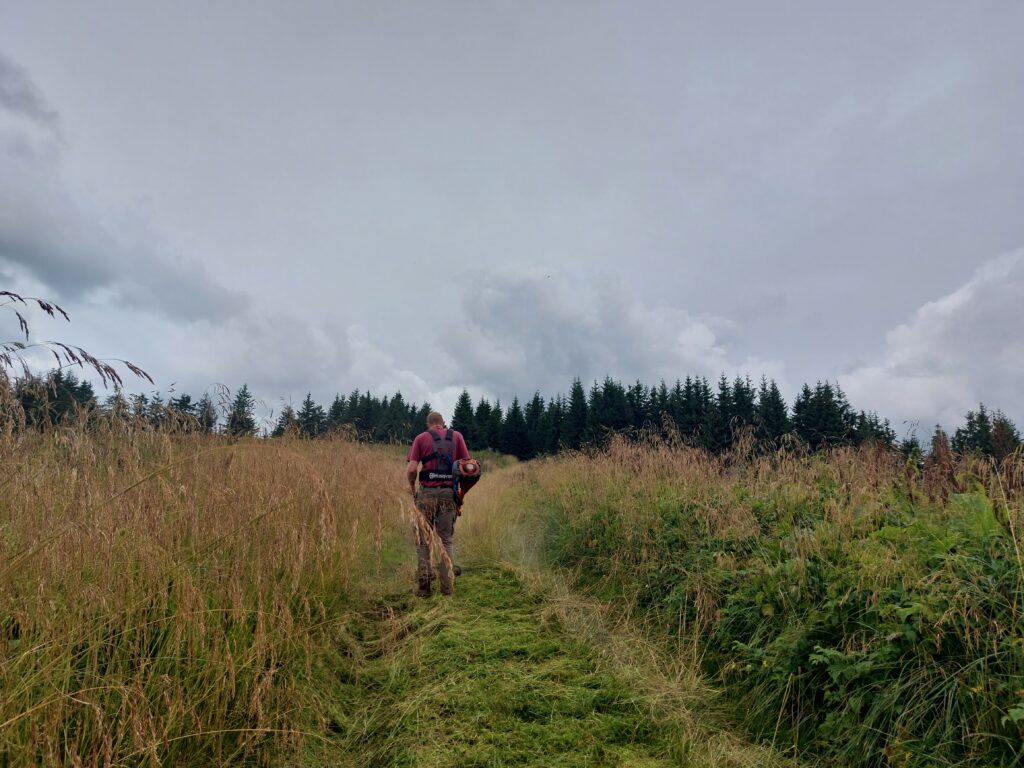
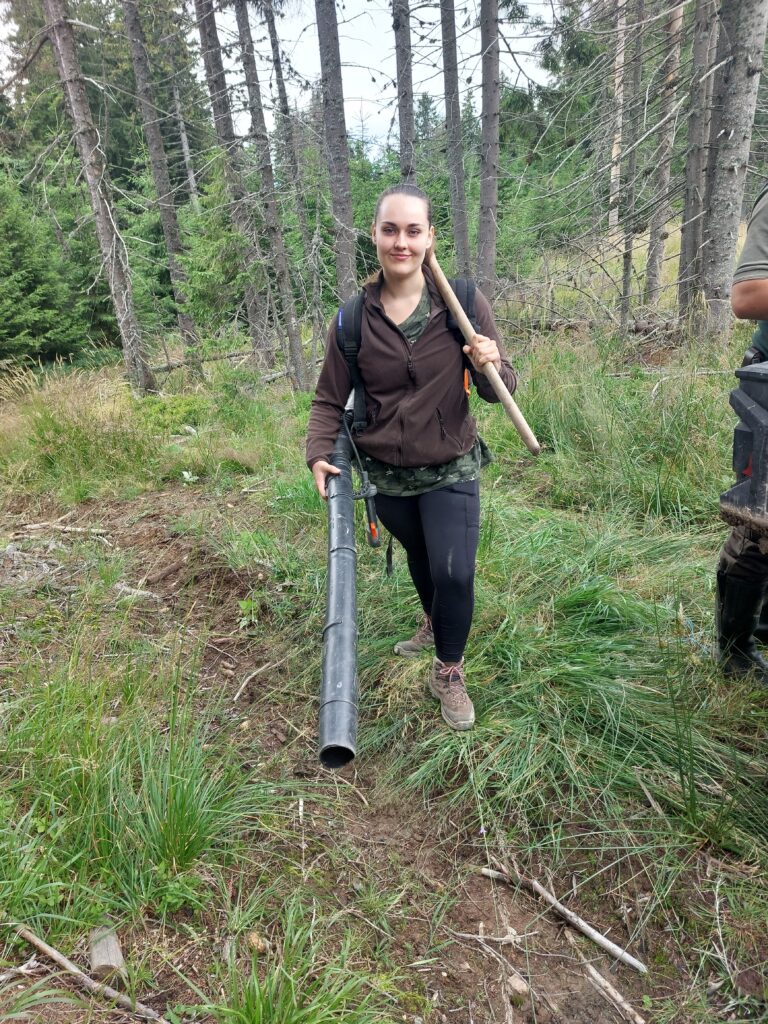
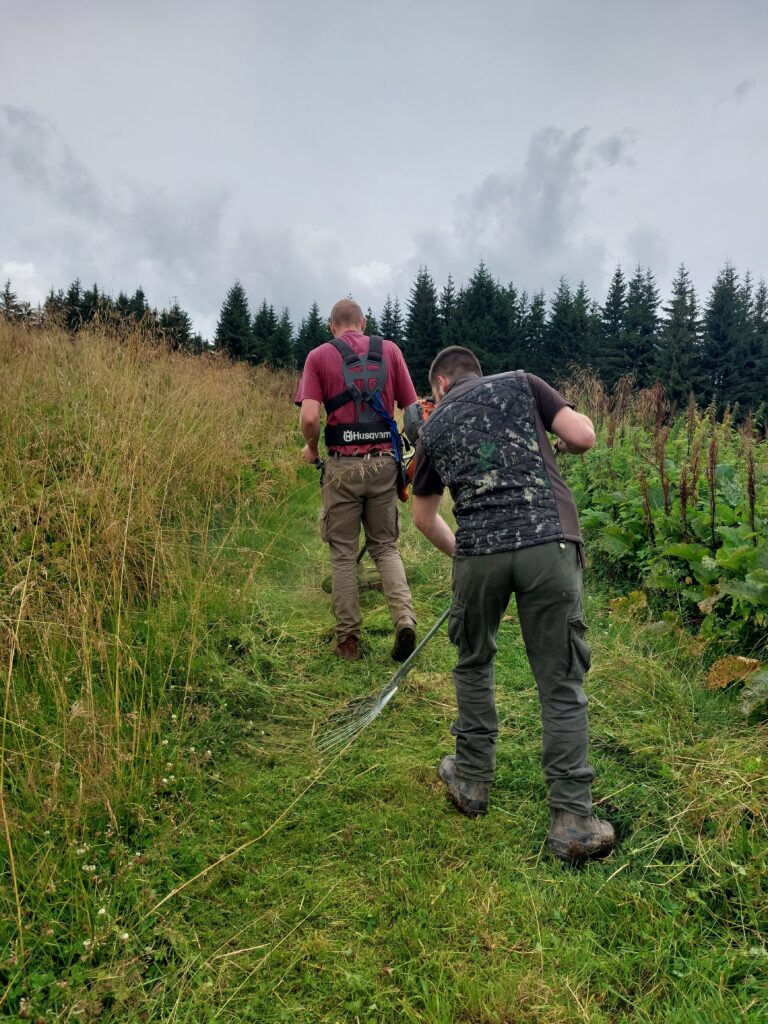
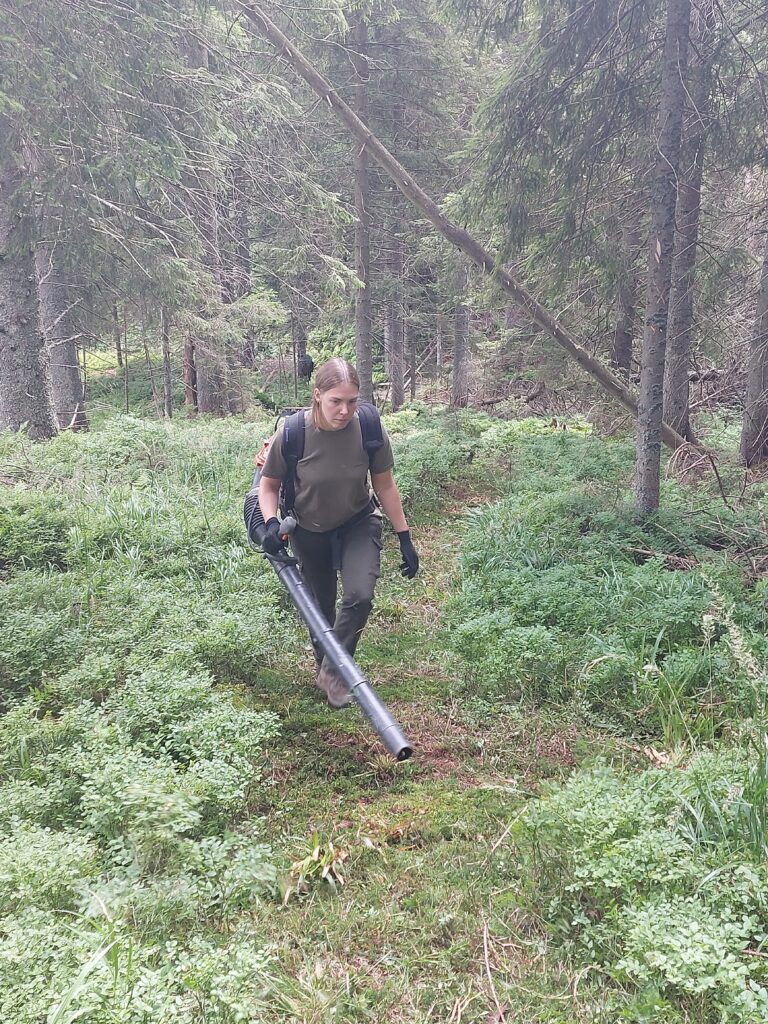
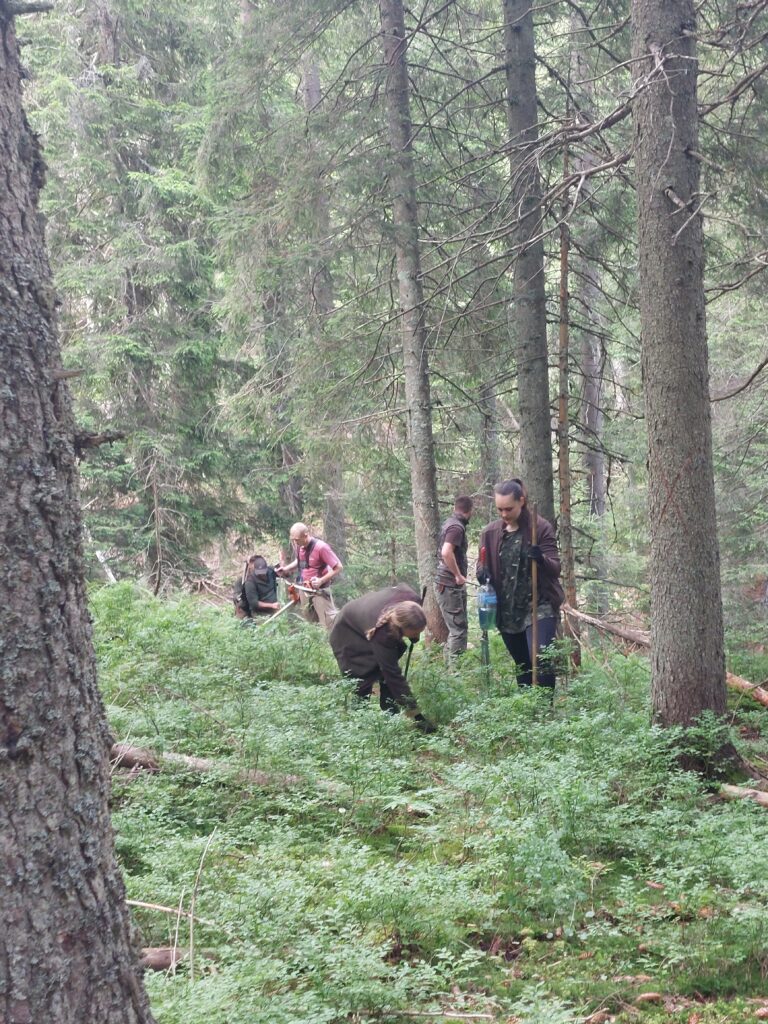
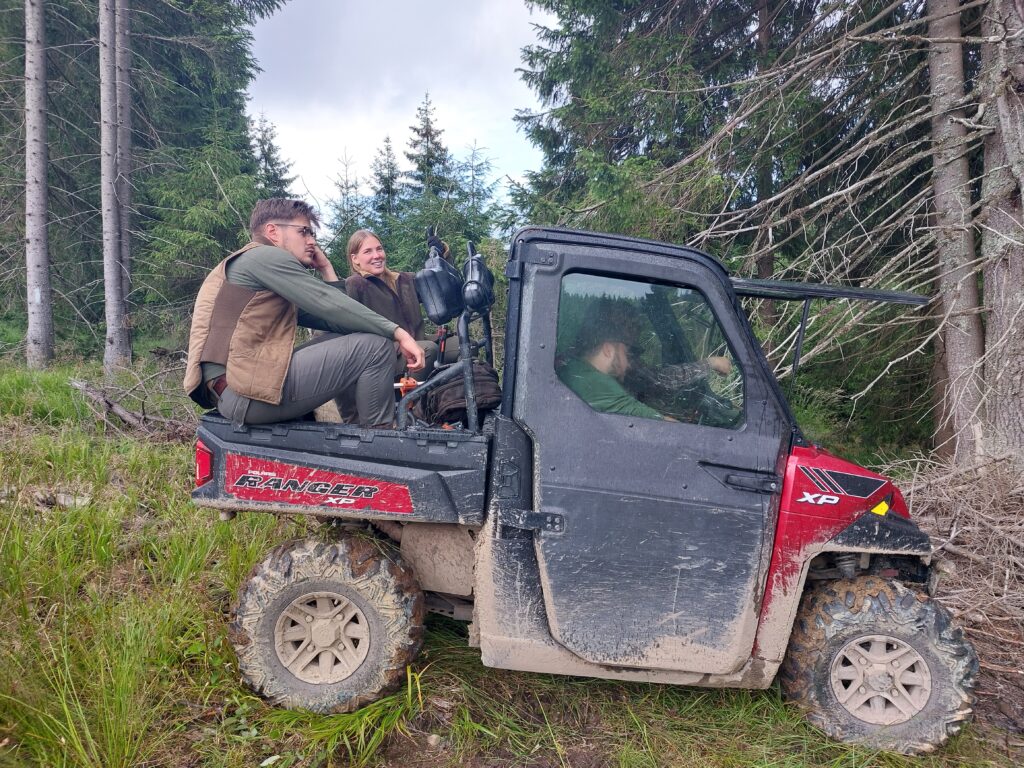
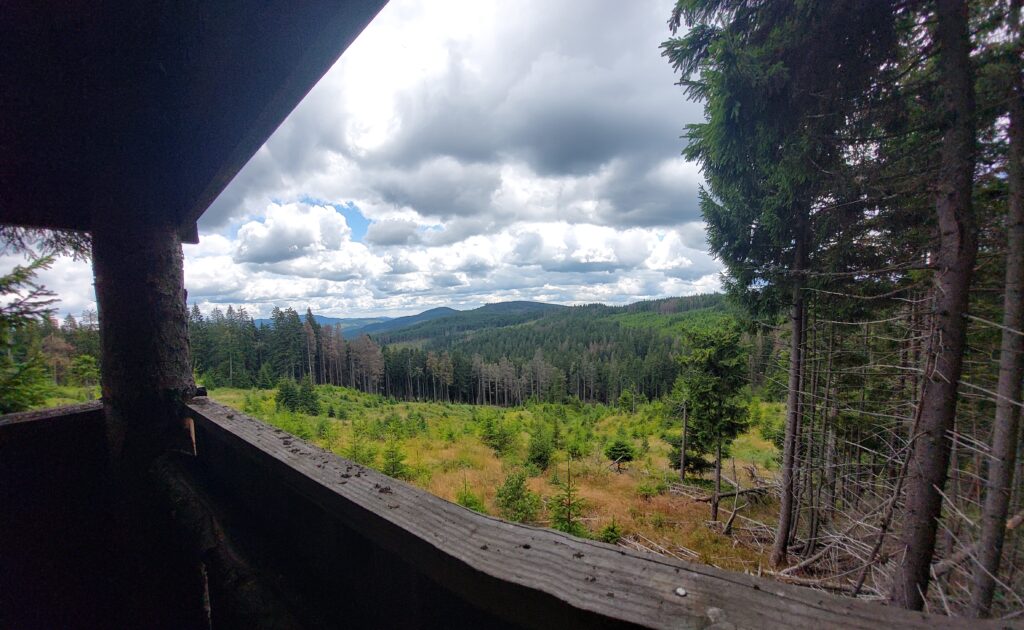

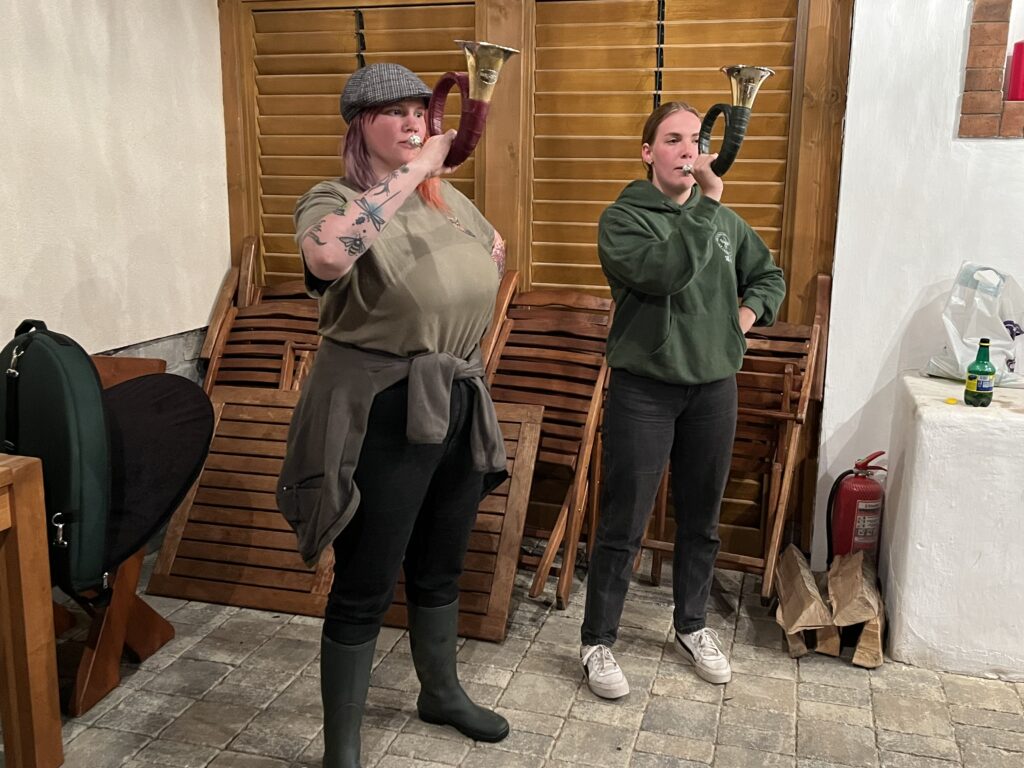
Gabriella Mészáros
All good things must come to an end and so we arrived at our last day. At 10 o'clock we gathered in the courtyard of the hunting lodge we had come to call home. We started loading bales of hay into the bed of Ritchie's car to fill the feeders, including the one that was our test piece. We started our journey at spreader 4. Here, we first had to remove the old hay to make room for the fresh supply. Meanwhile, Anna, Bodza and Matthew were renovating a "bridge" to keep you from sinking in the tide while visiting the spreader. The feeder that we built was filled from the inside by me. It was really fun trying to spread the bales inside the structure.
As a farewell, we went up the hill opposite Lakócsa to an abandoned shepherd's hut where we had a barbecue and talked. The rain had come down, but our spirits remained high and the food, as always, was impeccable.
On the way back we drove up to Lakóca, where we were treated to breathtaking scenery. I feel this was a fitting end to our two-week Transylvanian internship.
It was hard to say goodbye to everyone, people have grown with us and the village has grown with us. If I have the opportunity to come back in the future, I would like to return here once again and I hope that the forest of Kommando, surrounded by mountains, will welcome me as an old friend..
Fülöp Anna Flóra
The last day we spent here was no longer about work. Attila checked the practical logbooks at 10am and then we said goodbye. These two weeks of practice in Transylvania have been a gift to us, I have never felt so much fun in my life, and the time has gone by so fast.
The exercise made me realise even more that I want to go down this path, because if I enjoyed what I did here so much, I know I would do it even more at home and enjoy it even more. I have gained a lot of professional experience in the short 14 days that I will be able to use in this profession. I hope to have the opportunity to come back in the future and be a useful member of the future team.
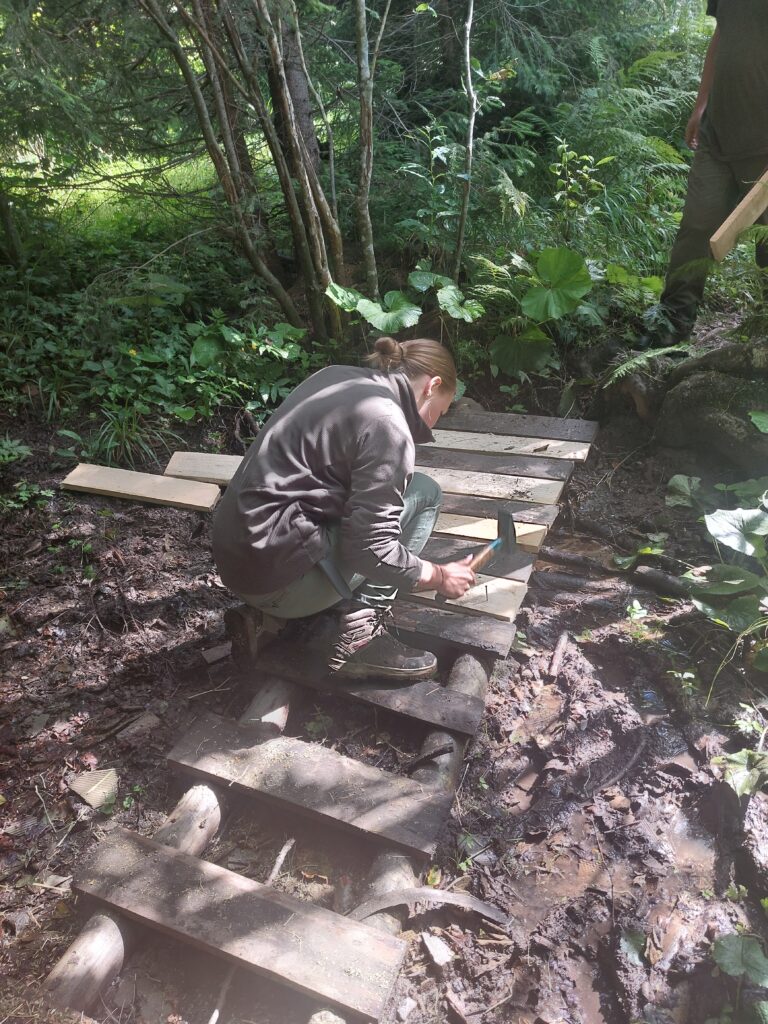
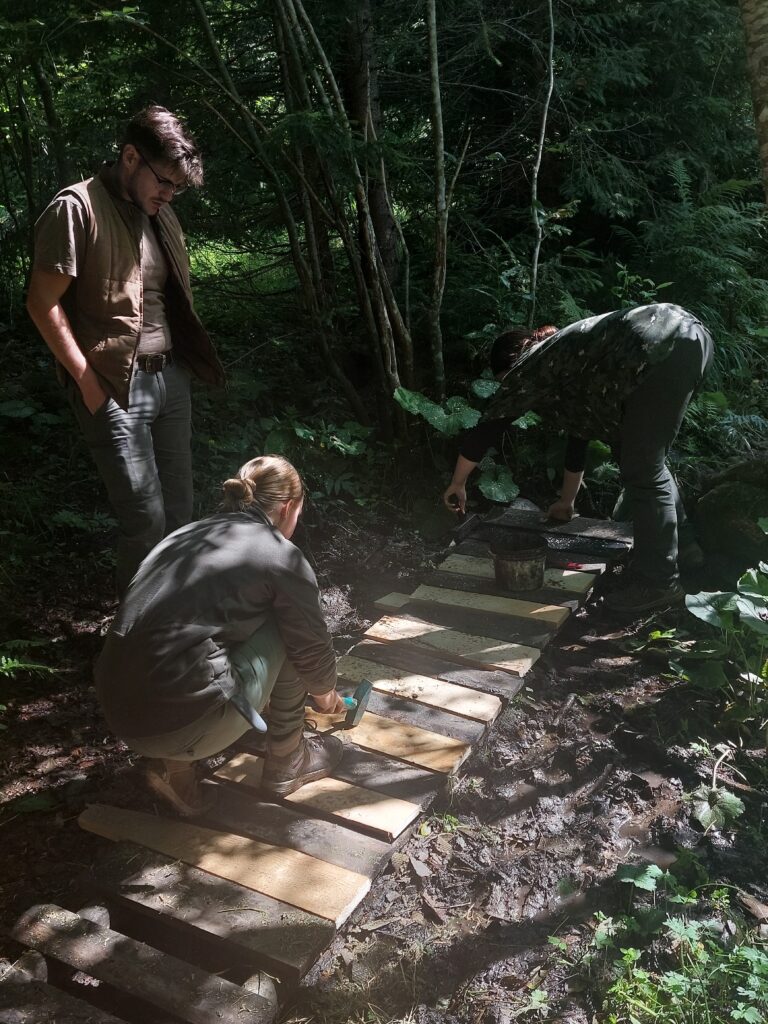
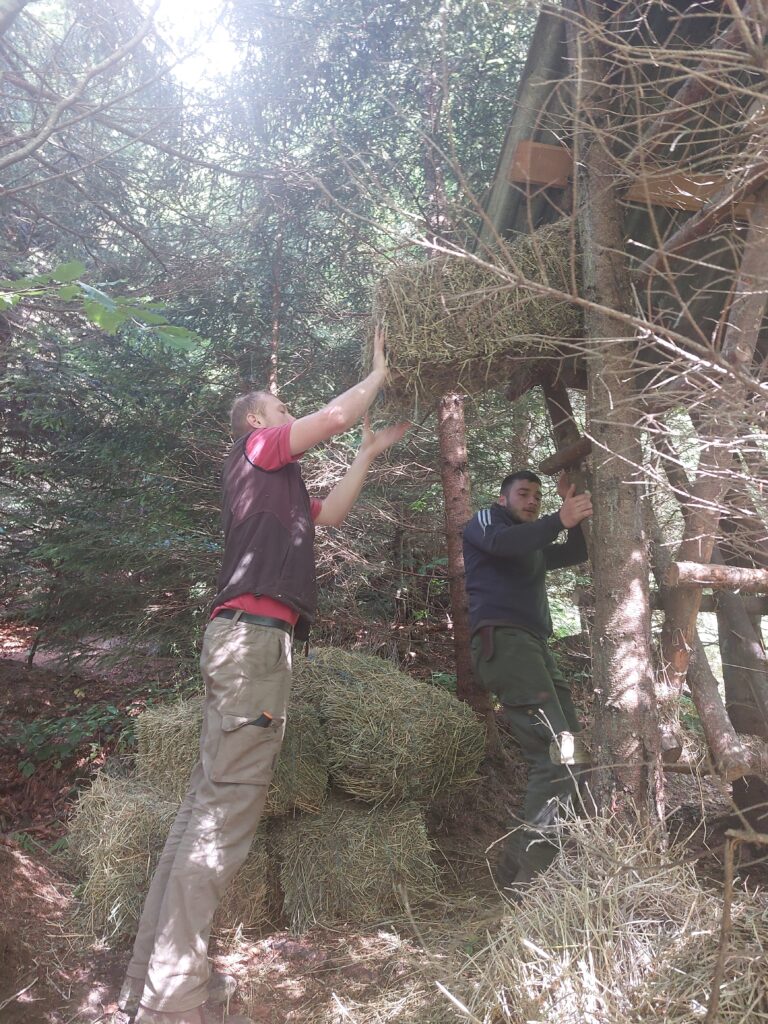
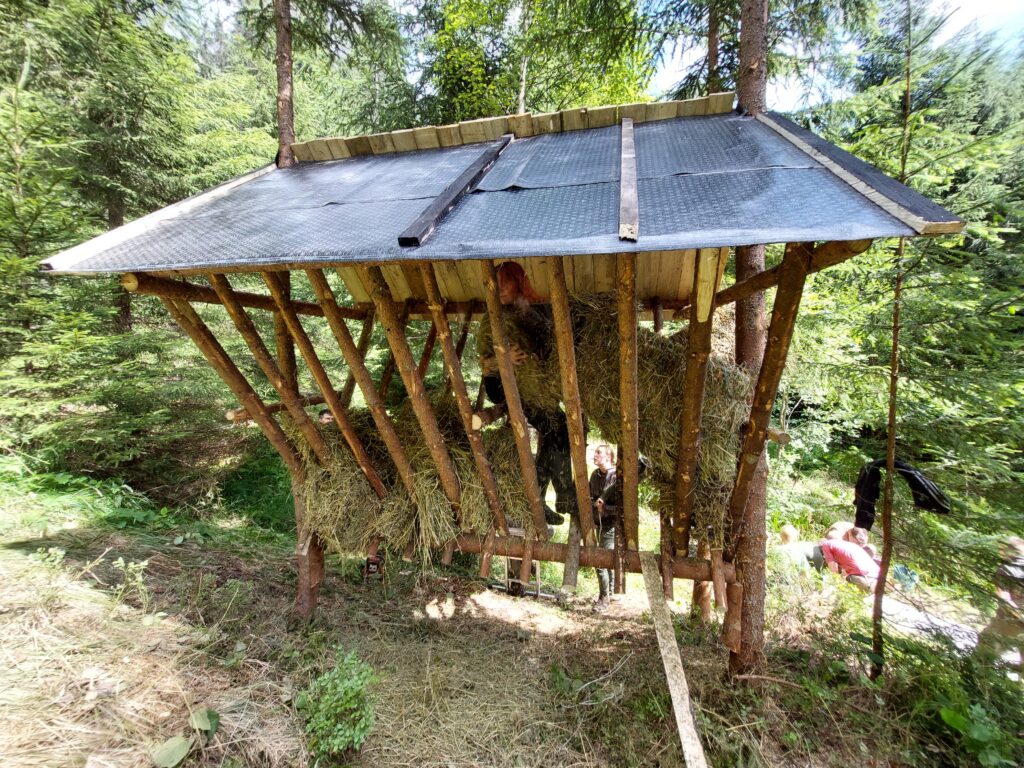

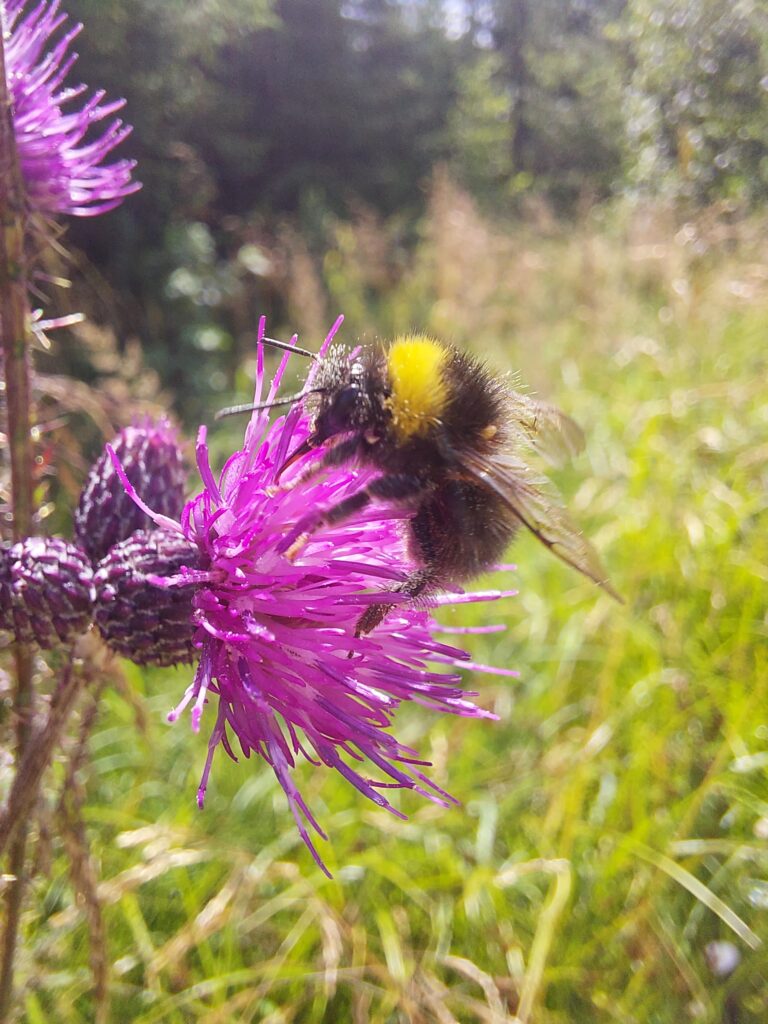
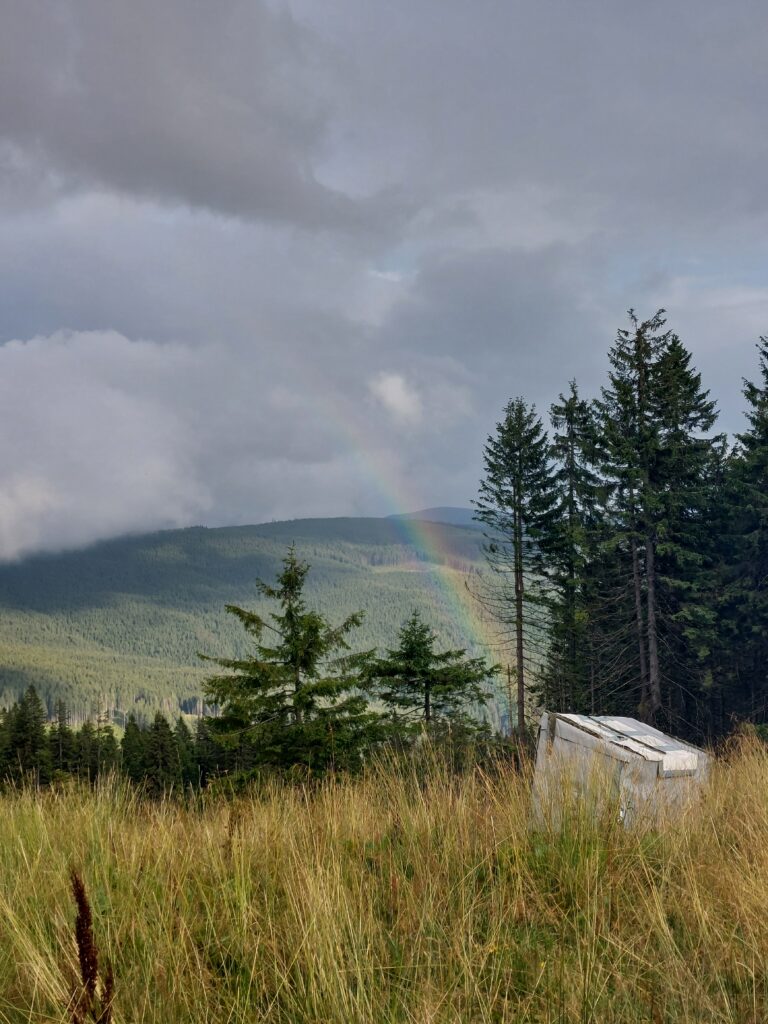
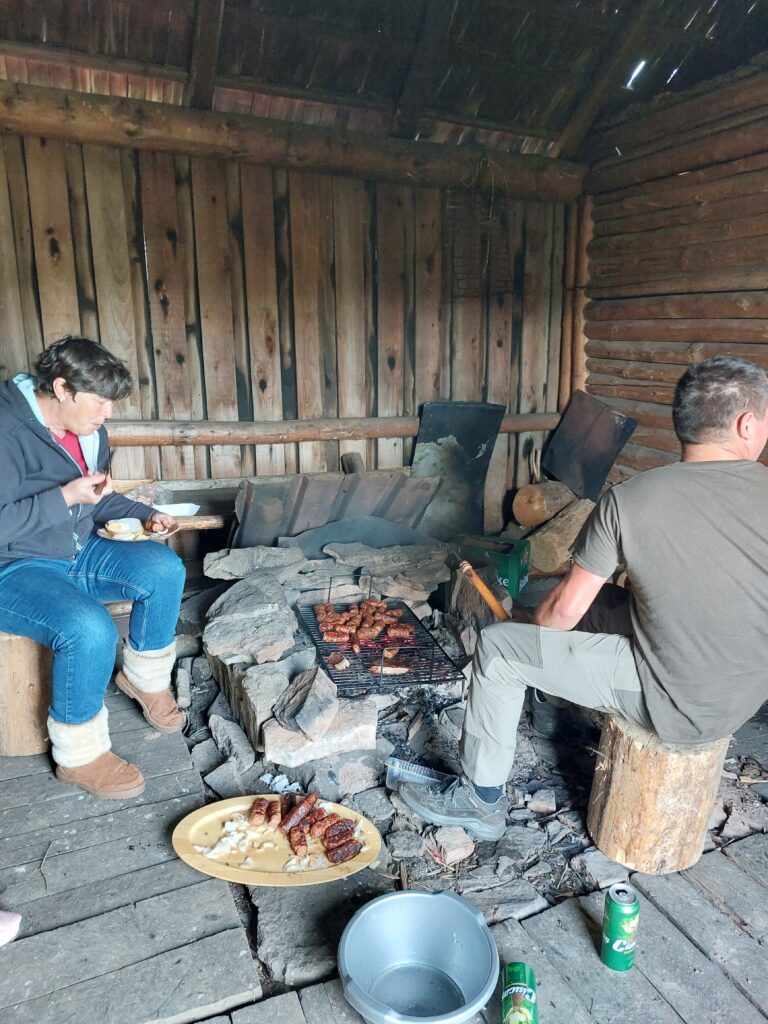

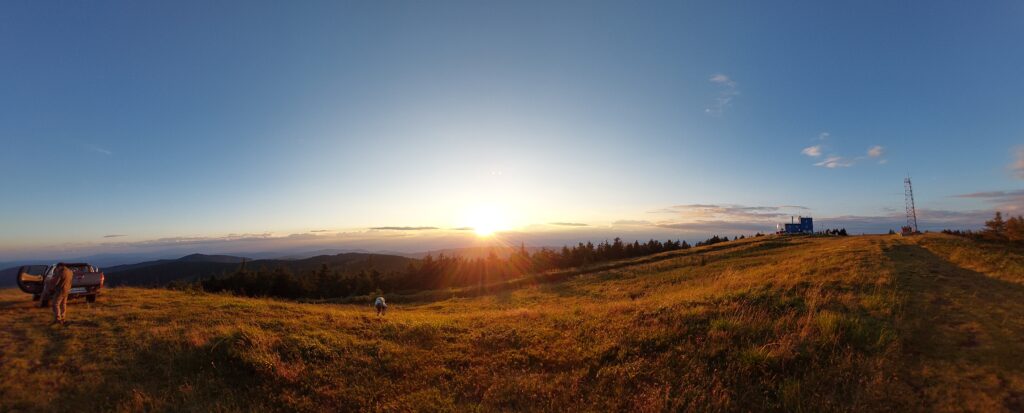
Cover photo by Boglárka Csapó Bodza
